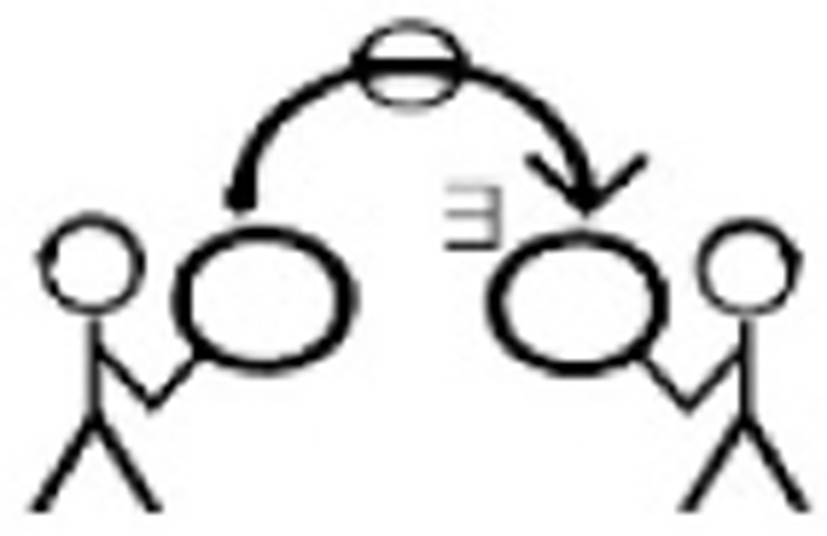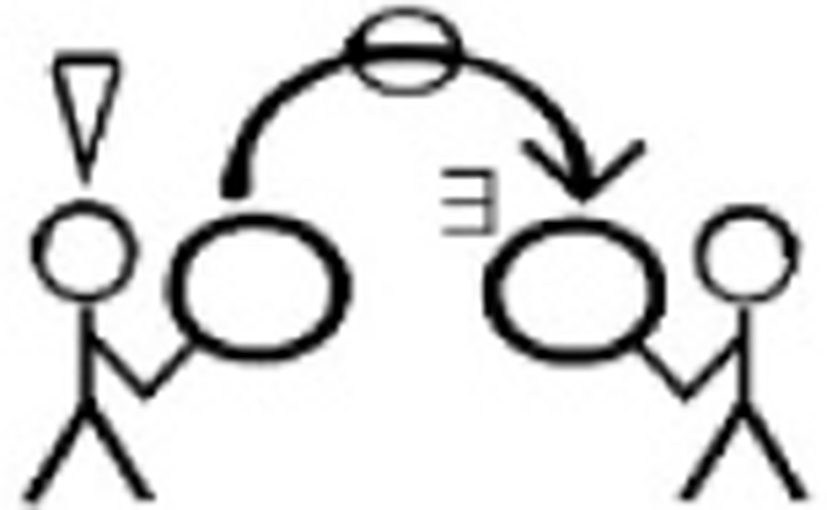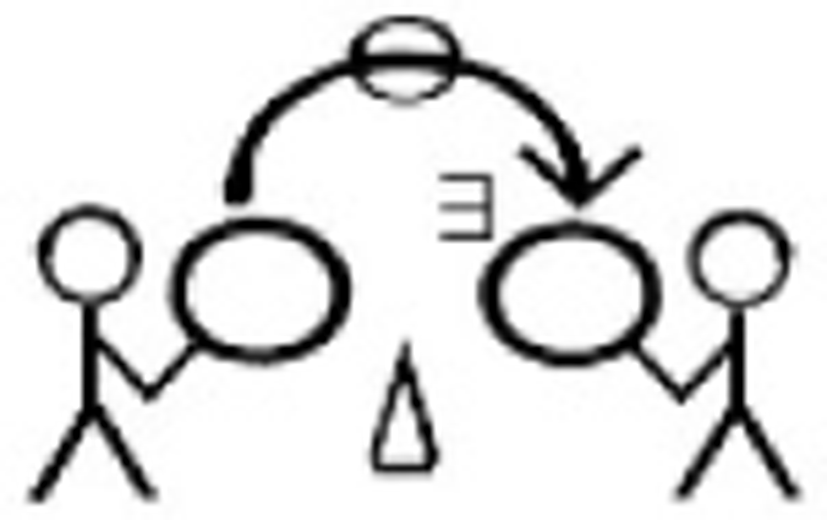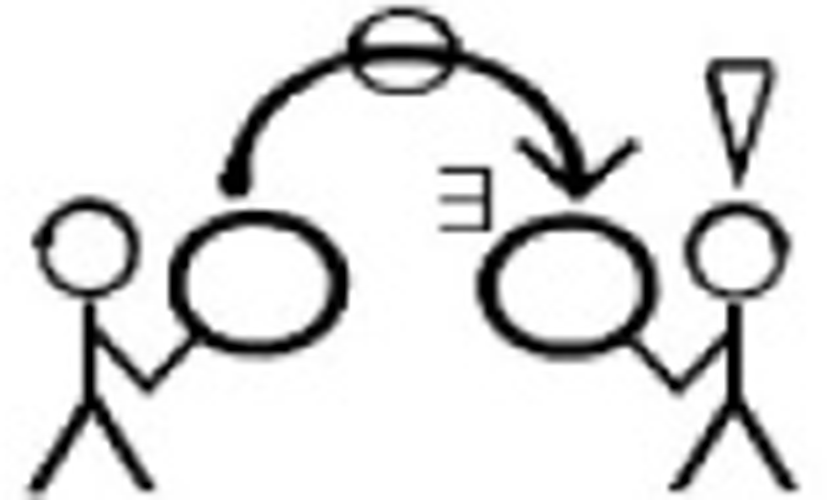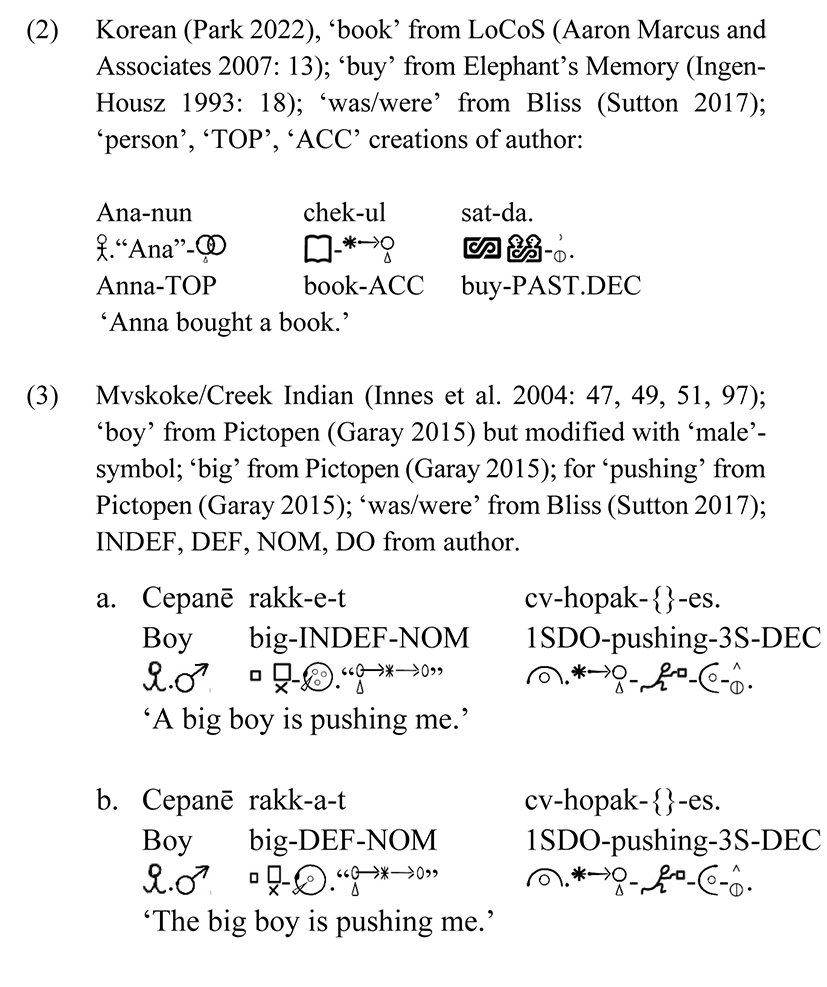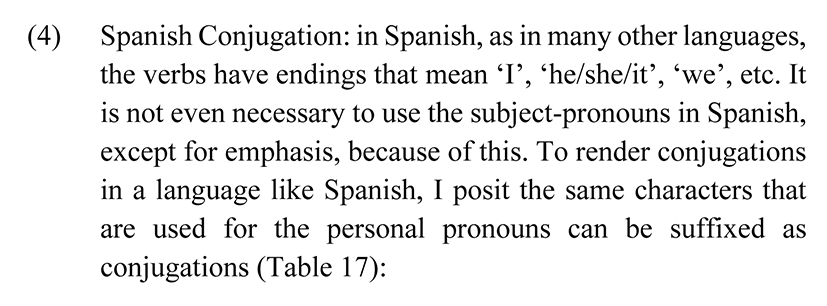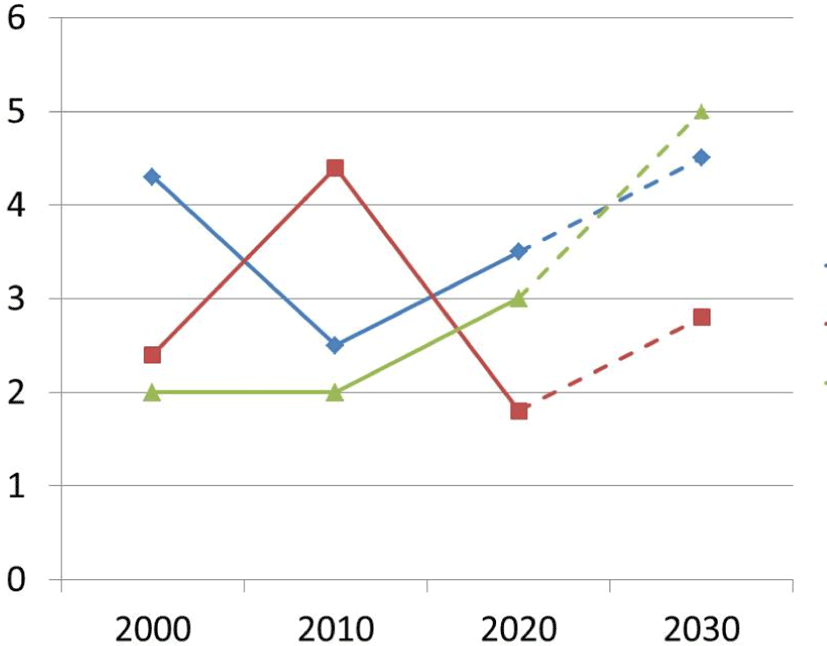1. Introduction: Principles for Maximizing Representation
Since at least the 1600’s, great minds such as René Descartes, Gottfried Leibniz, Sir Francis Bacon, Johann Becher, Jan Comenius, George Dalgarno, Francis Lodowyck, Gerardus Vossius, Seth Ward and Rev. John Wilkins have proposed, or even attempted, the creation of a universal writing consisting only of semantic symbols, rather than phonological symbols as comprise the Hangul or the Roman Alphabet (Lodowyck 1647; Wilkins 1668; Cornelius 1965: 29, 32–33, 37, 52, 72, 76, 80; Cram & Maat 2001: 2, 4–8, 14, 16–17, 21, 27–28, 39, 42, 47, 64–65, 171, 213, 241, 368, 372, 379, 421, 423, 426; Maun 2016, 2018). Of the various attempted projects, none is fully complete in the view of the present author or others such as Maun (2017); Blissymbolics, also known as “Bliss”, is perhaps one of the most complete, yet still could use some more development and refinement. The purpose of this paper is to propose three principles to aid in the creation and/or refinement of such semantic-writing systems.
To have a functioning semantic-writing system or “ideography”, “pasigraphy”, “real character”, etc., we need characters. We need enough characters to represent the universe, but we do not want so many characters that nobody will be able to learn and remember them.
I posit that if we apply some principles aimed at getting the most meaning and meanings out of the fewest characters, then we can reasonably attempt the creation, completion, or refinement of a semantic-writing system which will not pose a memory-burden to the average person. In this article, I propose some such principles.
In Section 2, I argue that the simple device of the arrow or other selector can be used to coax much more meaning from characters than Egyptian, Chinese and Mayan do without its use; In fact, I apply the arrow to Egyptian, Chinese and Mayan characters in order to illustrate the increased richness of expression which this simple and intuitive device can evoke.
In Section 3, I push for most “things”1 to be represented by derived forms of radicals or from combinations of radicals rather than having their own radicals.2 I propose a series of “radical-disqualifiers” to greatly reduce the number of basic characters required in a semantic-writing system. To illustrate here briefly, one likely wouldn’t think of creating a unique character for something as specific as ‘#2 Phillips-head screwdriver’; I suspect most of us would sense that such an item should be represented by a string of characters, rather. My proposed set of radical-disqualifiers formalizes a process of deciding which things, concepts, or notions deserve their own radicals, and which should be derived from a radical, or represented by two or more of them.
In Section 4, I illustrate that we may be able to have more radicals without increasing our memory-burden, if we are consistent in building our characters from smaller “sub-elements”, symbols with consistent meanings which exist in multiple characters. In other words, if the smallest unit of semantic representation is the sub-element of the character, rather than the character itself, then our memories might be able to cope with many more characters.
These three strategies, I believe, will substantially advance the possibility of the creation of a functioning and complete semantic-writing system by maximizing the expression of our characters, thus avoiding overstraining the memories of the users of such a system.
2. The Arrow/Selector/Indicator to Derive Multiple Meanings from One Radical
Before we begin this section, consider the following Egyptian character: 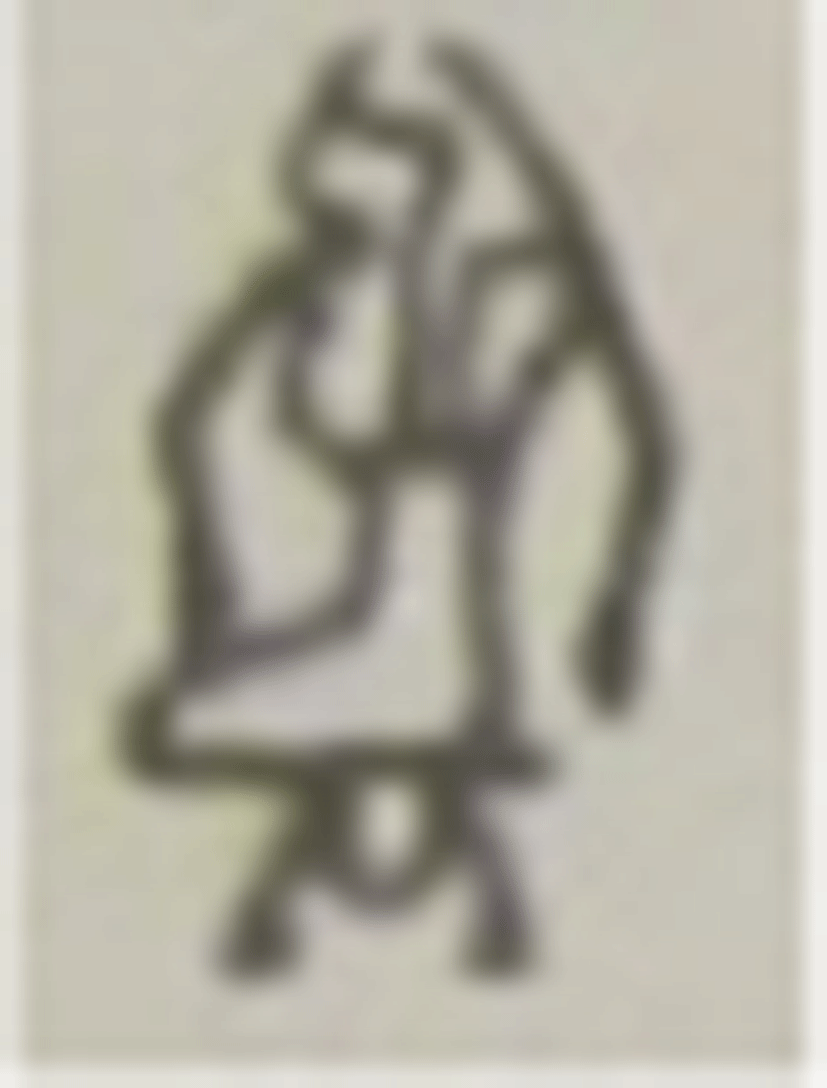 (Budge 1983: 51). Does this character mean ‘giving birth’?, ‘Being born’?, ‘Woman giving birth’?, ‘Newborn infant’?
(Budge 1983: 51). Does this character mean ‘giving birth’?, ‘Being born’?, ‘Woman giving birth’?, ‘Newborn infant’?
What about this Mayan character:  (Matthews & Bíró 2007)? Does it mean ‘face’?, ‘Head’?, ‘Hair’?, ‘Eyes’?, ‘Mouth’?
(Matthews & Bíró 2007)? Does it mean ‘face’?, ‘Head’?, ‘Hair’?, ‘Eyes’?, ‘Mouth’?
Or this Native American petroglyph: 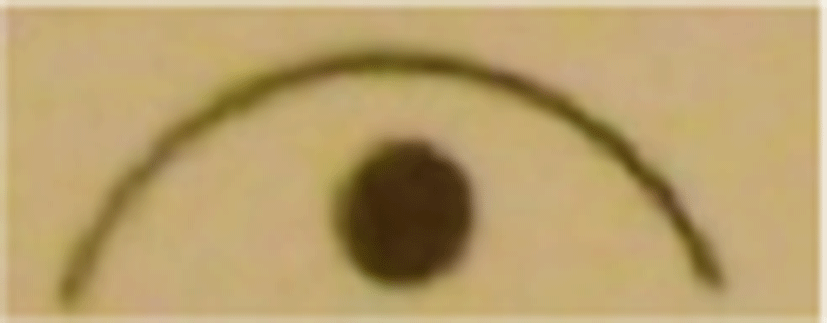 (Martineau 2003: 28–29, 49). Can you guess whether it means ‘state of covering/hiding’, ‘covered/hidden’ or ‘thing which covers/hides’?
(Martineau 2003: 28–29, 49). Can you guess whether it means ‘state of covering/hiding’, ‘covered/hidden’ or ‘thing which covers/hides’?
This determining which piece of a character is its meaning, and which pieces are context, is the issue discussed in this section.
The goal is to represent everything in the world while having few enough characters so that users can remember them. In Section 2, I show the tremendous usefulness of the simple arrow or other selector/ indicator at multiplying possible meanings derived from a radical.
It is worth noting that Egyptian, Chinese and Mayan do not, or did not, maximize their potential semantic expressiveness via this simple device. Let us consider and examine some examples in which the arrow could be of great service rendering representations.
My first example showing how the arrow could appreciably increase the number of concepts representable in a semantic writing comes from Egyptian hieroglyphics. Let us consider  (Budge 1983: 51), transcribed as “mes” or “pāpā”, and glossed as ‘a parturient woman, to give birth’. In other words, the character refers either to the woman engaged in the action of giving birth, or to the action of giving birth. Yet with the aid of an arrow directed at the woman, this symbol could have specified ‘parturient (woman)’; similarly with an arrow directed at the emerging infant, the meaning of ‘(baby) being born’ could have been had (Table 1):
(Budge 1983: 51), transcribed as “mes” or “pāpā”, and glossed as ‘a parturient woman, to give birth’. In other words, the character refers either to the woman engaged in the action of giving birth, or to the action of giving birth. Yet with the aid of an arrow directed at the woman, this symbol could have specified ‘parturient (woman)’; similarly with an arrow directed at the emerging infant, the meaning of ‘(baby) being born’ could have been had (Table 1):
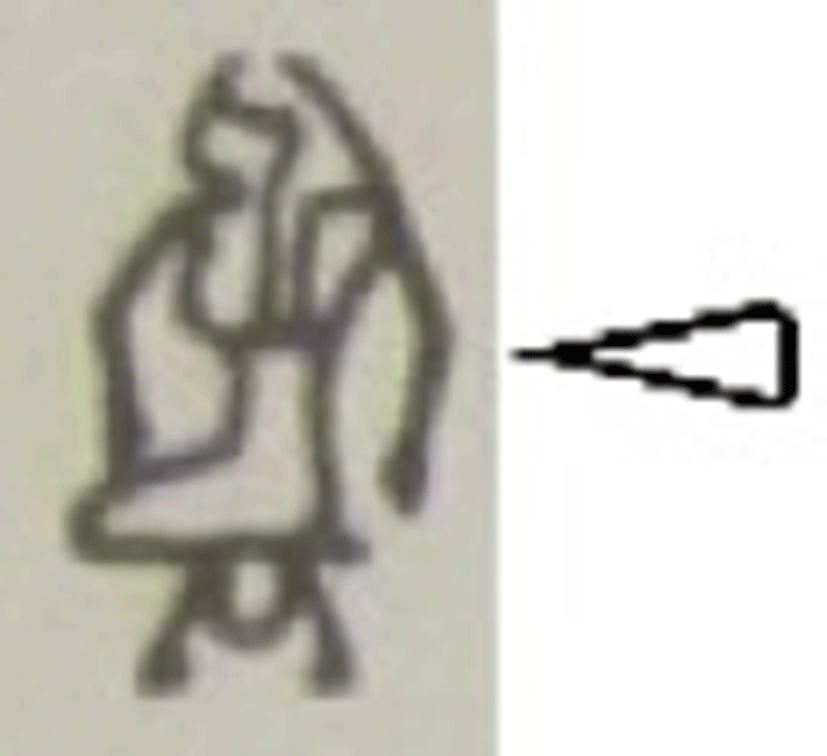
|
‘any woman (or female of another species) who gives birth’ |
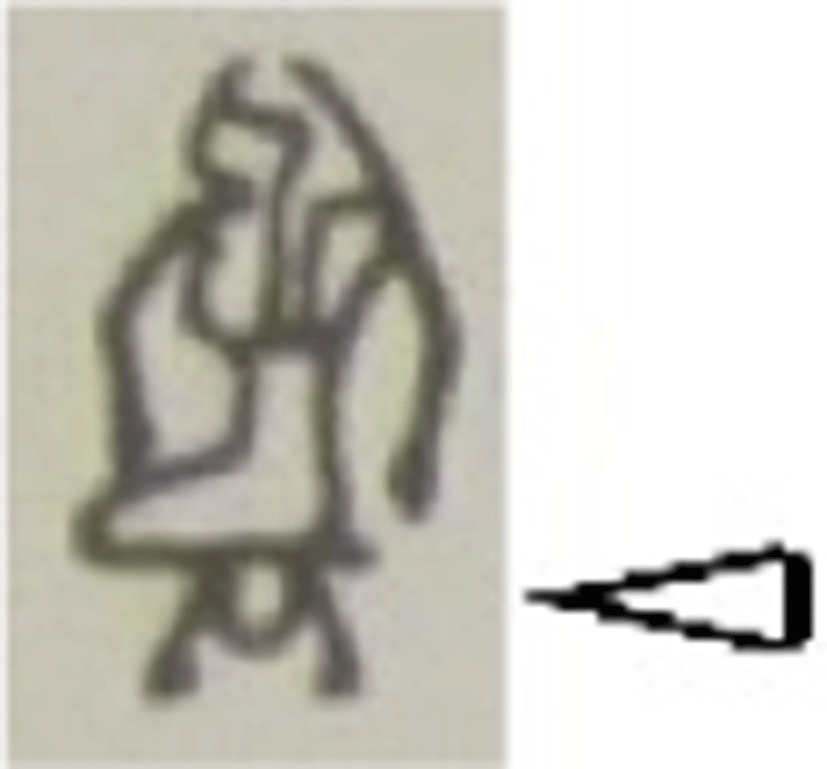
|
‘(any infant who is) born’ |
In other words, more than one meaning could have been assured from this one basic symbol, rather than deduced from context. Numerous other Egyptian symbols similarly depicted actions of humans or animals, and could have similarly used arrows to specify thematic roles3 such as ‘doer’ or ‘done-to’, as opposed to the action itself.
If we were going to apply arrows as I propose above, then what would  , with no arrows, mean? For characters showing action, I propose that the radical be assigned the meaning of the complete action both active and passive, in this case, ‘any action of giving birth/being born’. I realize this meaning may not often be needed, but it encompasses the entire action; Arrows serve to split off thematic roles from it. Gerunds such as “giving birth” or infinitives such as “(to) give birth” refer only to the active voice, which is only part of the entire action, so they are not accurate to convey the entire action; It takes both or all thematic roles to comprise the complete action which an action-radical represents.
, with no arrows, mean? For characters showing action, I propose that the radical be assigned the meaning of the complete action both active and passive, in this case, ‘any action of giving birth/being born’. I realize this meaning may not often be needed, but it encompasses the entire action; Arrows serve to split off thematic roles from it. Gerunds such as “giving birth” or infinitives such as “(to) give birth” refer only to the active voice, which is only part of the entire action, so they are not accurate to convey the entire action; It takes both or all thematic roles to comprise the complete action which an action-radical represents.
In Section 3, especially Sections 3.2 and 3.7, I discuss how meanings of verbs such as ‘give birth’, ‘gave birth’, ‘was born’, etc. can be built by combining the copula4 and an arrow or other indicator/ selector to indicate the thematic role such as ‘woman giving birth’ or ‘infant being born’, but for the moment, I will simply state my position that (Table 2):
| ‘was’+ |

|
= | ‘(was a woman who) gave birth’ |
| ‘was’+ |

|
= | ‘was (an infant who was) born’ |
The Modern Chinese character 車 ‘cart’, ‘wheeled vehicle’ (Harbaugh 2001), descends from more-pictographic Bronze versions such as 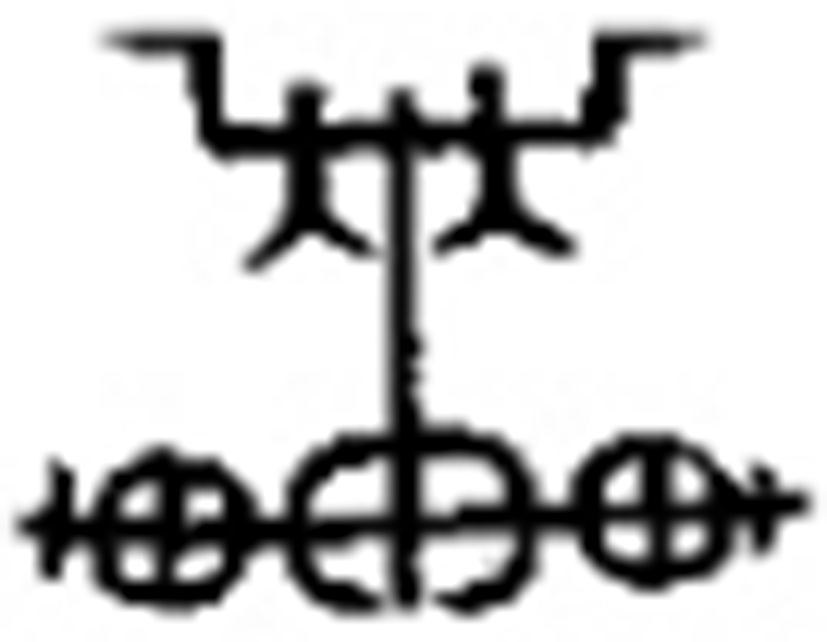 and
and 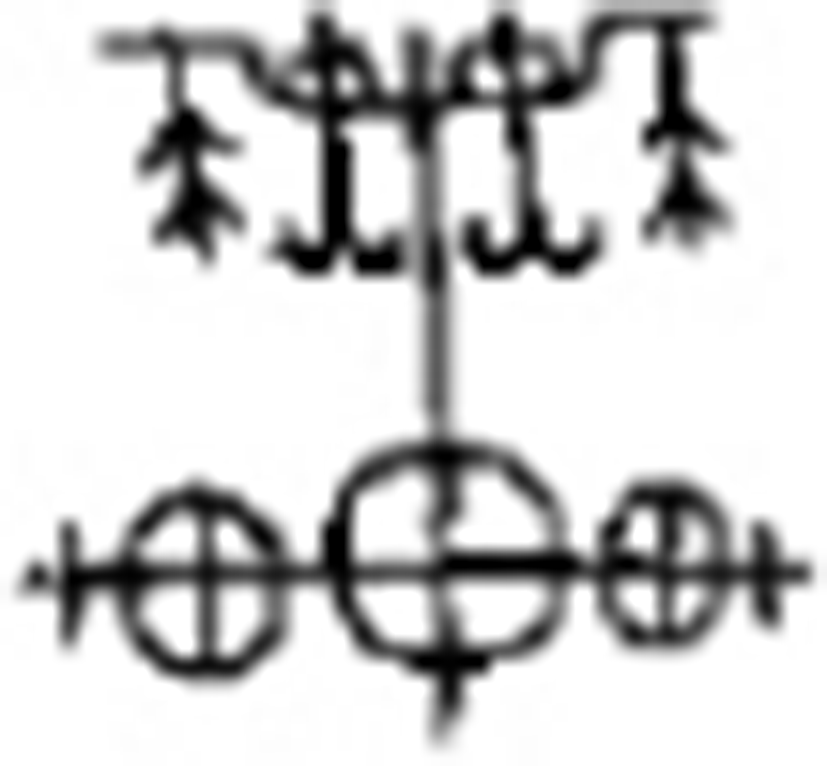 , showing an aerial view, or schematic, of a cart (Sears 2013).5
, showing an aerial view, or schematic, of a cart (Sears 2013).5
In Modern and/or Ancient Chinese, how are components of a cart, such as ‘wheel’, ‘axle’, ‘yoke’ and ‘seat’/‘passenger-compartment’, expressed? (Table 3).
| 輪 | ‘wheel’: this is ‘cart’ plus 侖 used as a phonetic (Harbaugh 2001, Sears 2013) |
| 軸 | ‘axle’: this is ‘cart’ plus 由 used as a phonetic (Harbaugh 2001, Sears 2013) |
| 軛 | ‘yoke’: this is ‘cart’ plus 厄 as a phonetic6 |
| 坐位 | ‘seat’/‘passenger-compartment’: the first character deals with ‘sitting’, and the second with ‘place’, together yielding ‘sitting-place; seat’7 (Harbaugh 2001, Sears 2013) |
Whereas above, we see six radicals employed to yield these meanings, by applying an arrow or other indicator to the more-detailed archaic character, the meanings of ‘wheel’, ‘axle’, ‘yoke’ and ‘seat’/ ‘passenger-compartment’ could have been derived from just the one radical for ‘cart’ (Table 4):
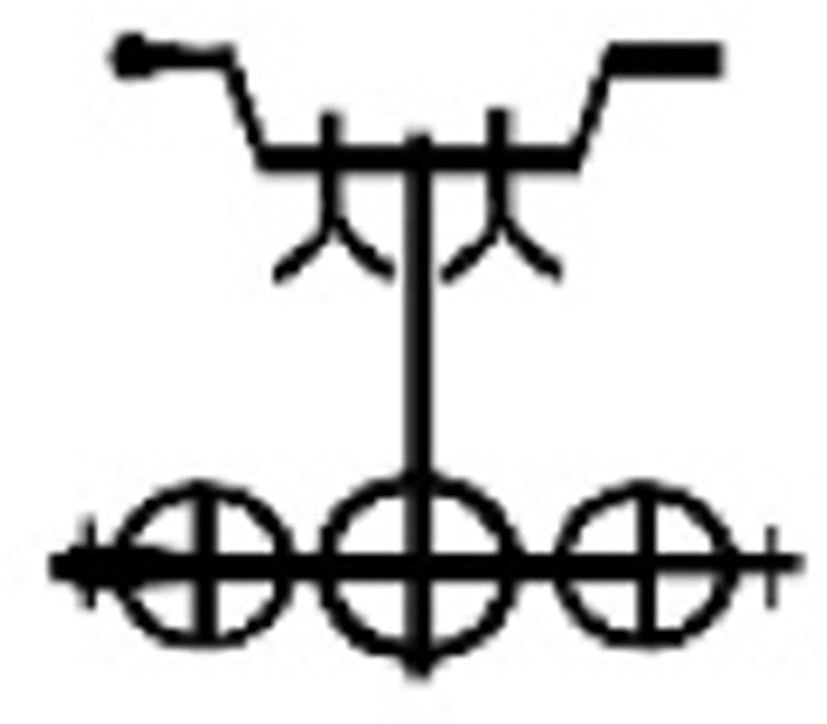
|
‘cart’8 |
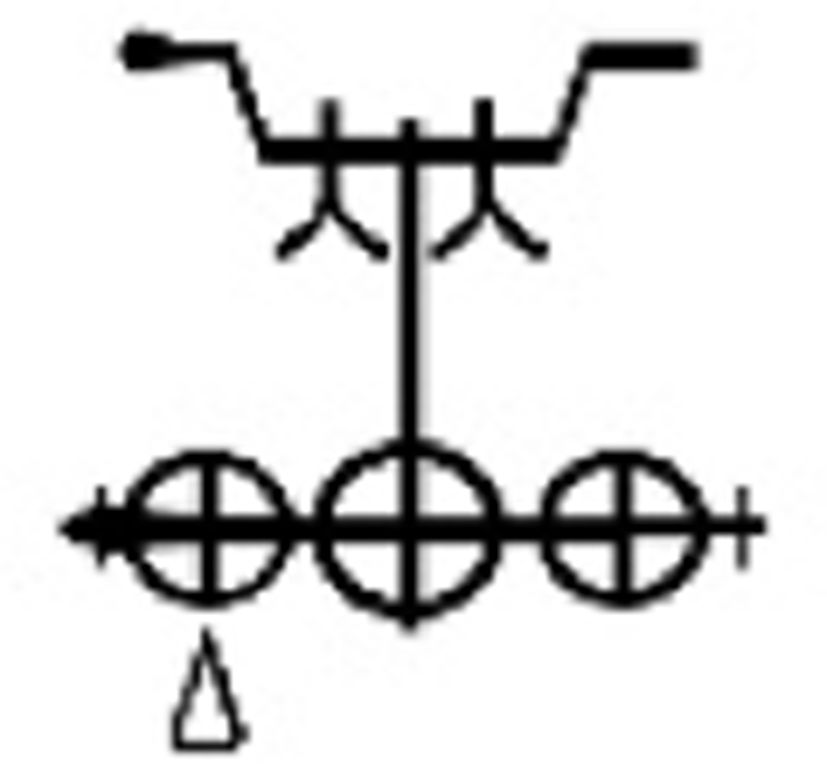
|
‘wheel’ |
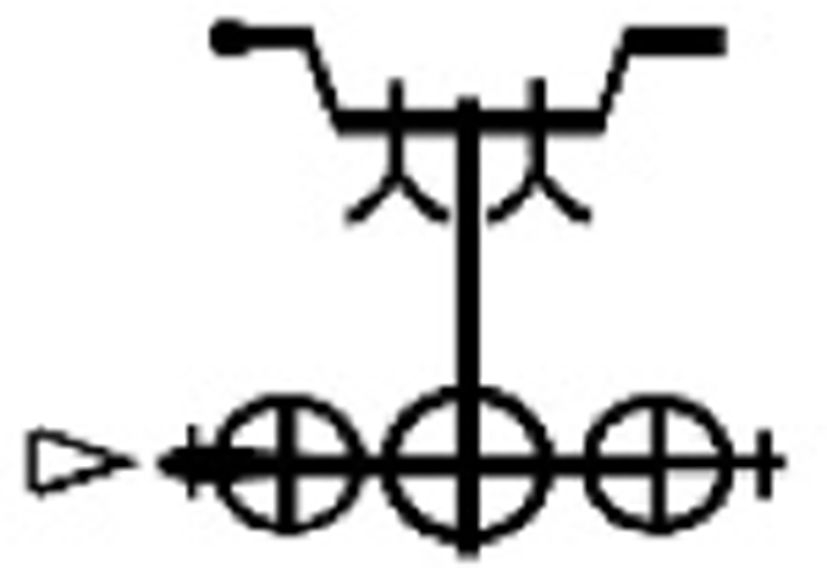
|
‘axle’ |
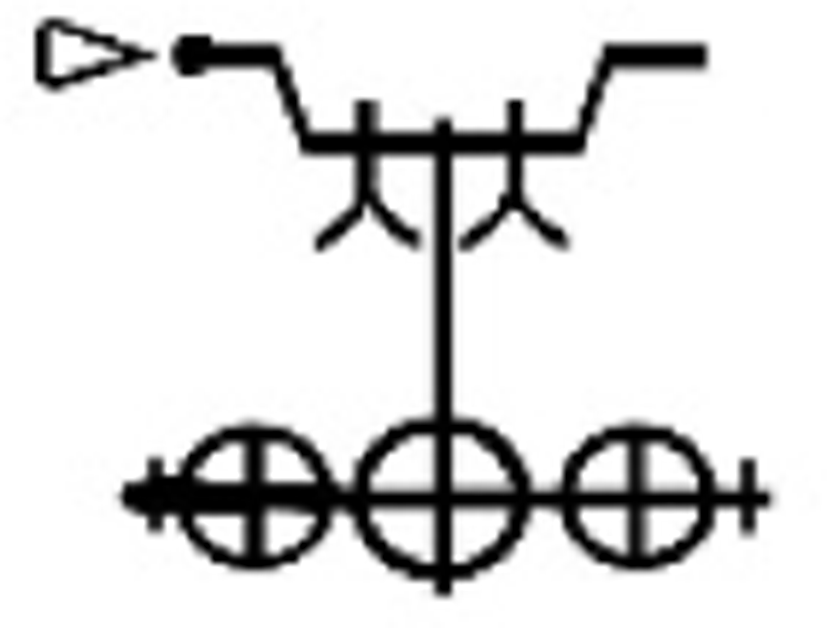
|
‘yoke’ |
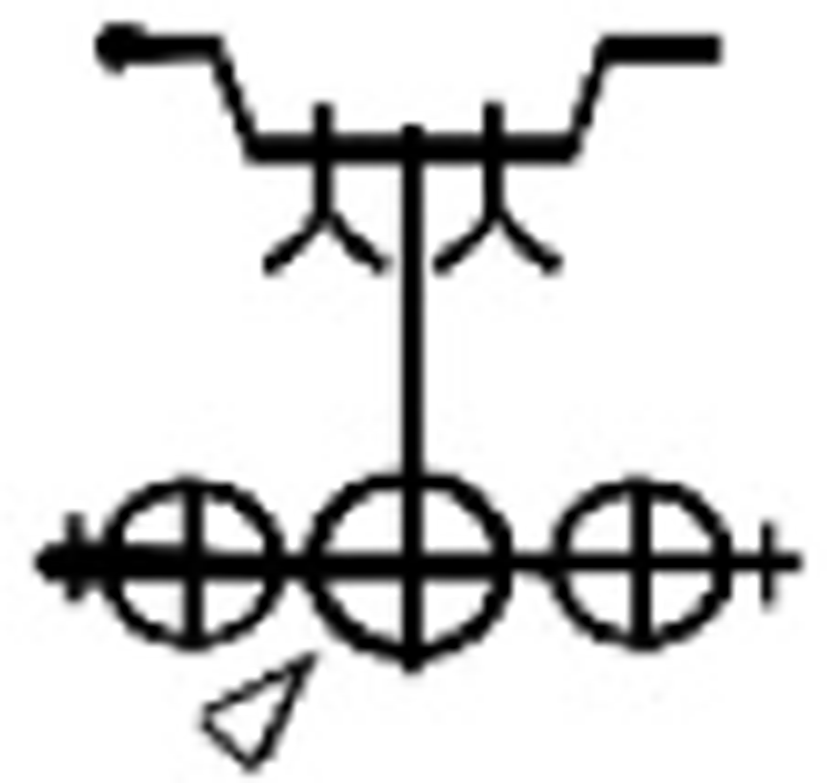
|
‘seat’/‘passenger-compartment’ |
In this case, four meanings could have been derived from the one radical for ‘cart’, avoiding the use of characters used as phonetics. I propose this would have eased the memory-burden for writers and readers of Ancient/Archaic and perhaps subsequent Chinese. In addition, no knowledge of spoken Chinese would be necessary to read these symbols since there would be none used for phonetic value, meaning that non-Chinese-speakers could more easily read Chinese.
Further examples of how the arrow could be used to derive multiple meanings from the same basic sign are found in the Mayan hieroglyphs for ‘nose’ and ‘mouth’.  is ‘nose’,
is ‘nose’, 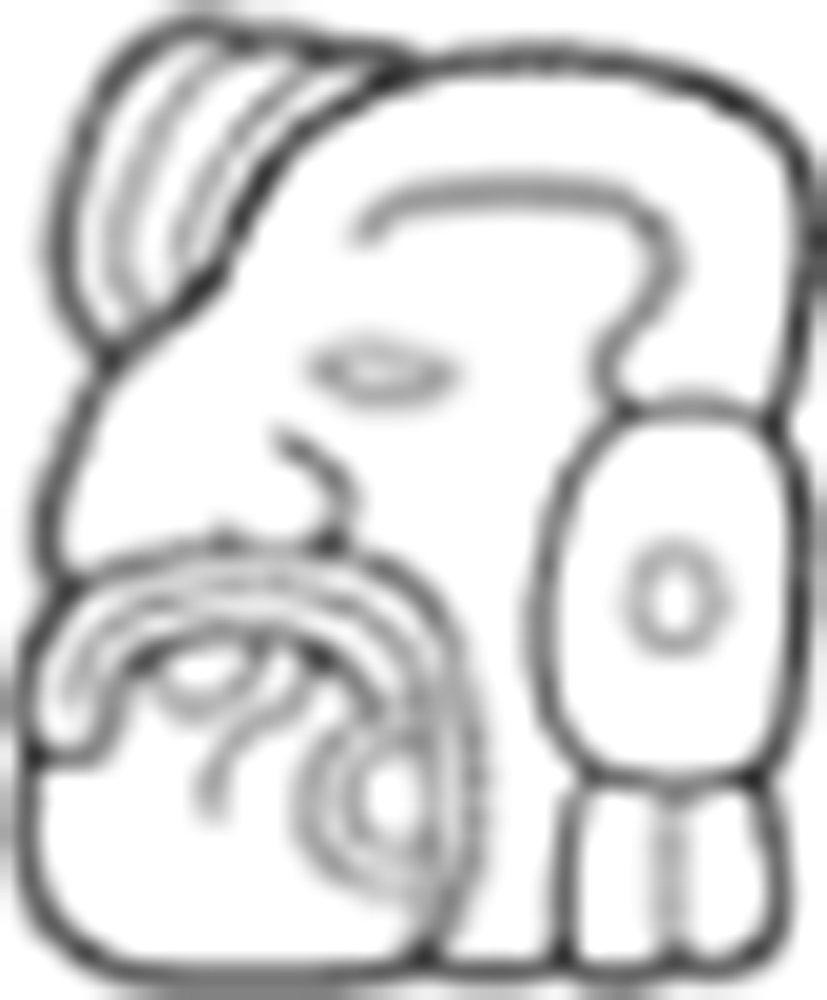 is ‘mouth’ and
is ‘mouth’ and 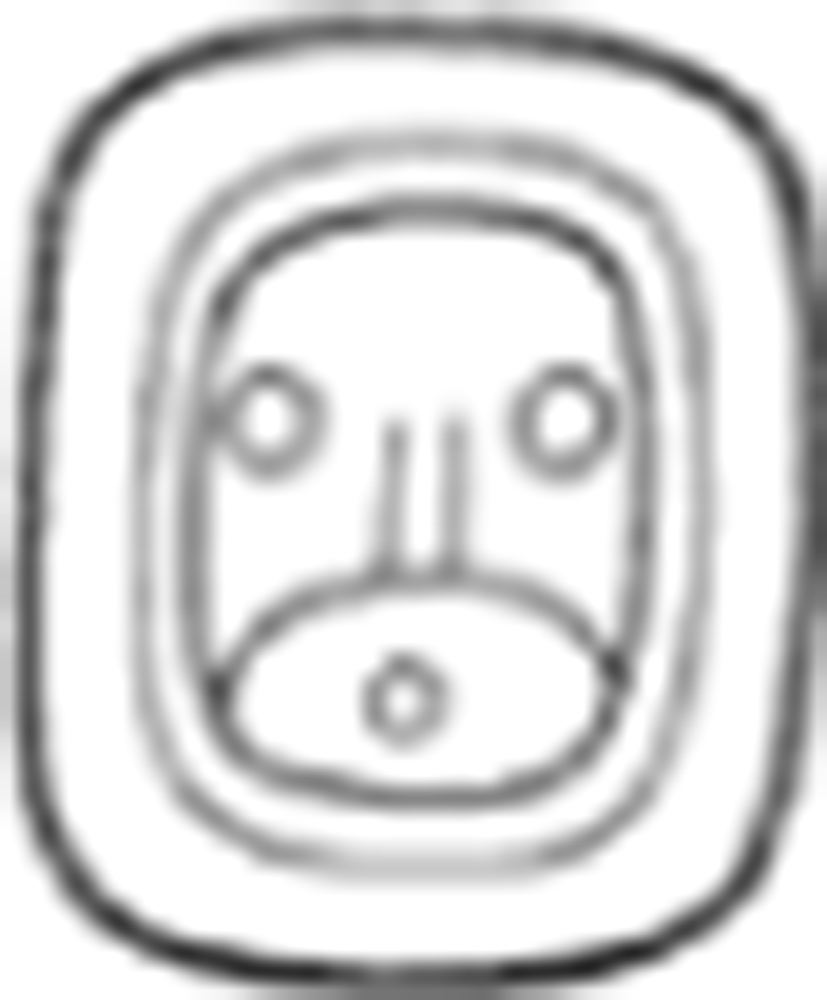 is ‘face’ (Matthews & Bíró 2007). Yet the radical
is ‘face’ (Matthews & Bíró 2007). Yet the radical 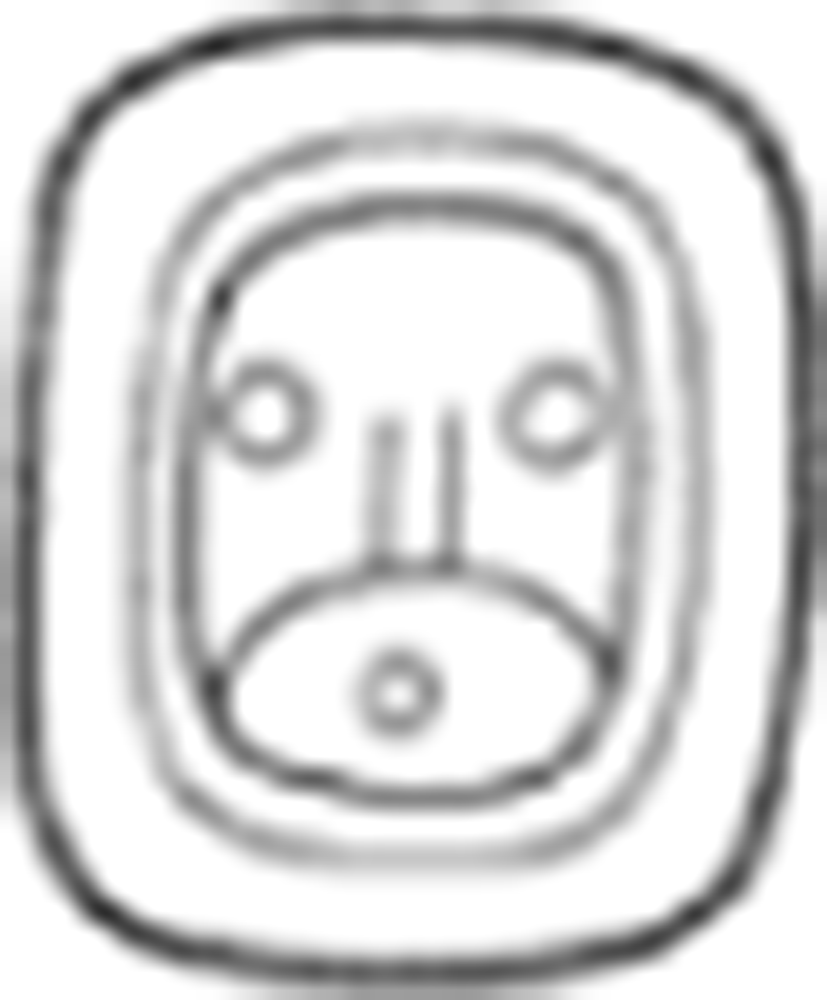 with arrows applied to it could have yielded both ‘nose’ and ‘mouth’ without the need for these two additional radicals. Furthermore, ‘eye’ could have been represented this way, and possibly ‘cheek’ and ‘forehead’ and ‘chin’ (Table 5).
with arrows applied to it could have yielded both ‘nose’ and ‘mouth’ without the need for these two additional radicals. Furthermore, ‘eye’ could have been represented this way, and possibly ‘cheek’ and ‘forehead’ and ‘chin’ (Table 5).
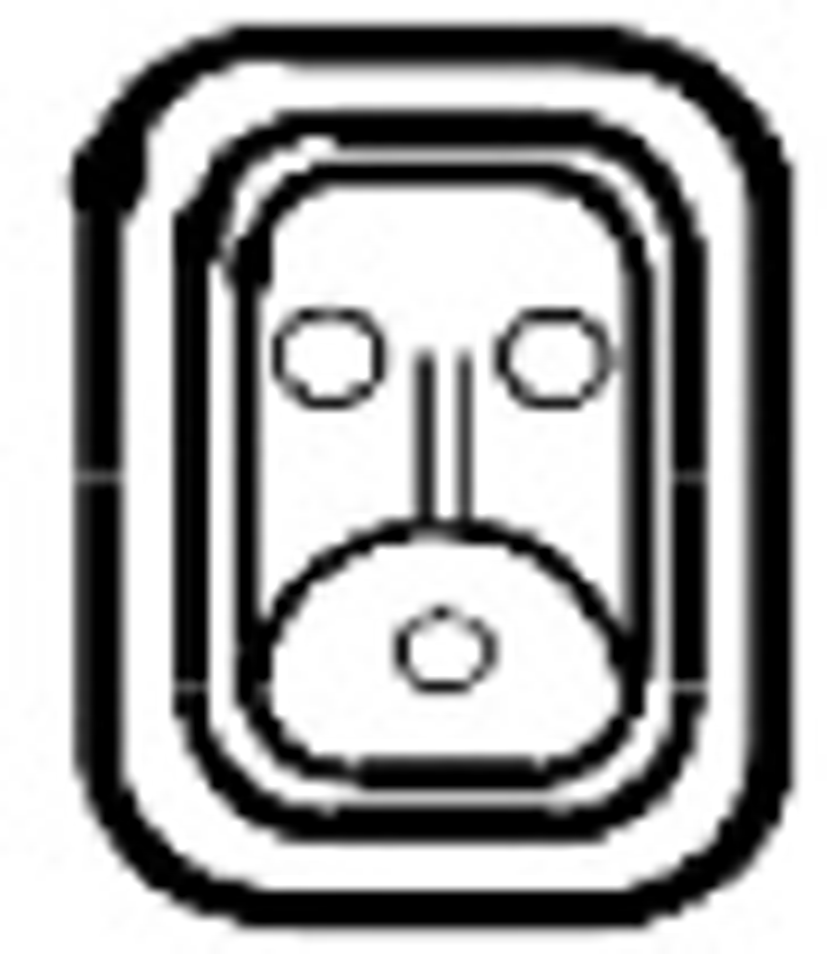
|
‘face’ |
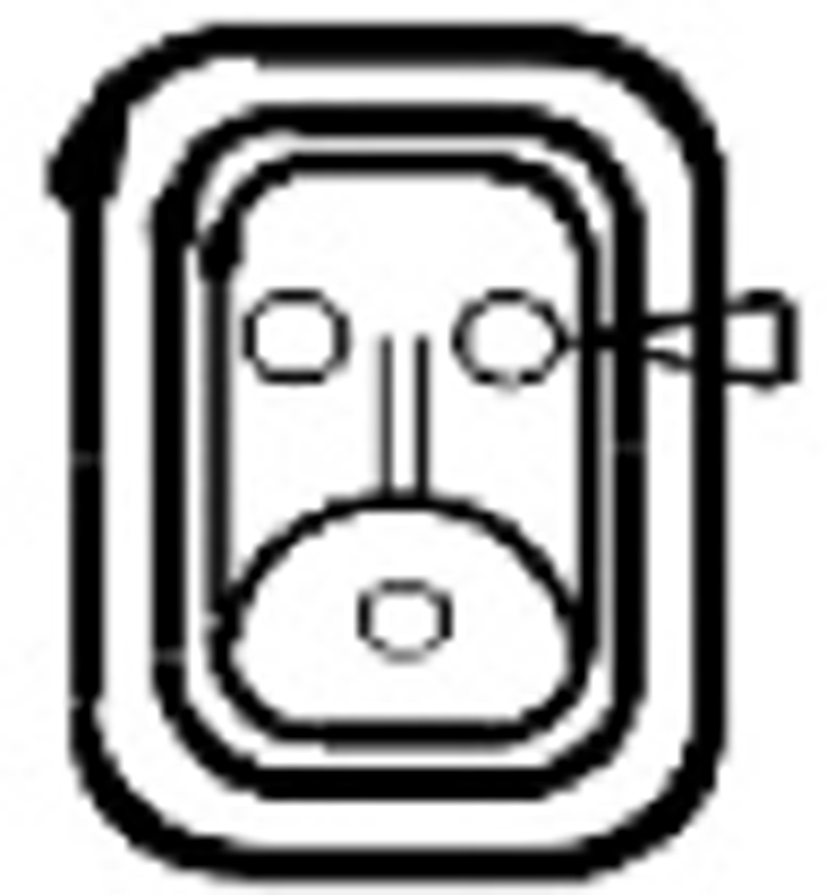
|
‘eye’ |
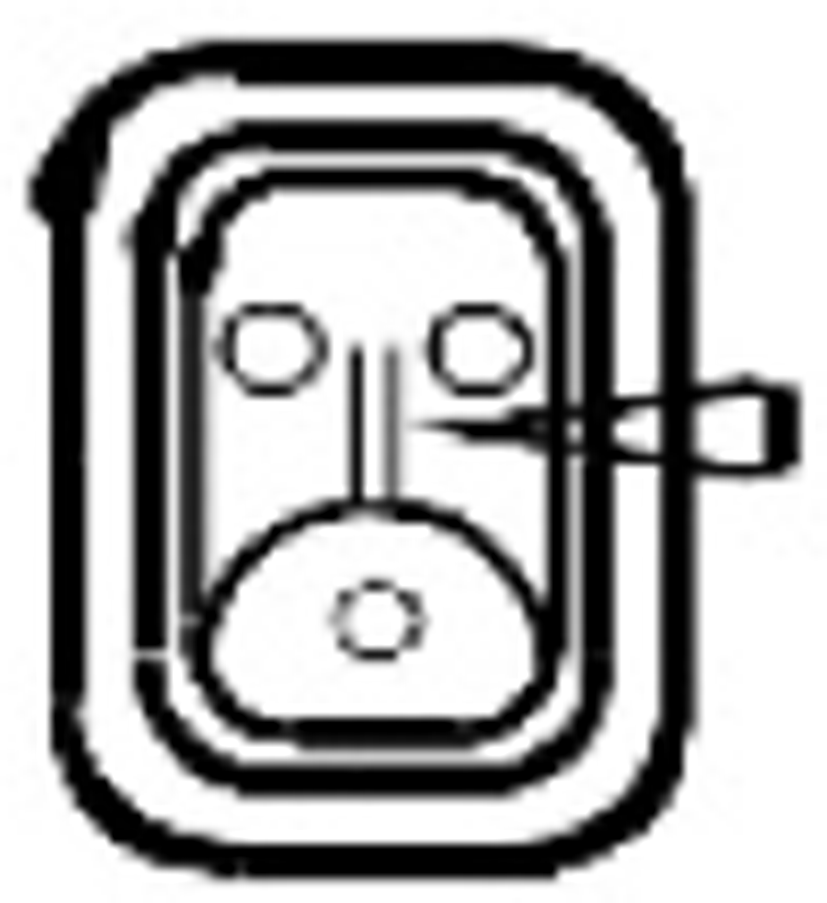
|
‘nose’ |
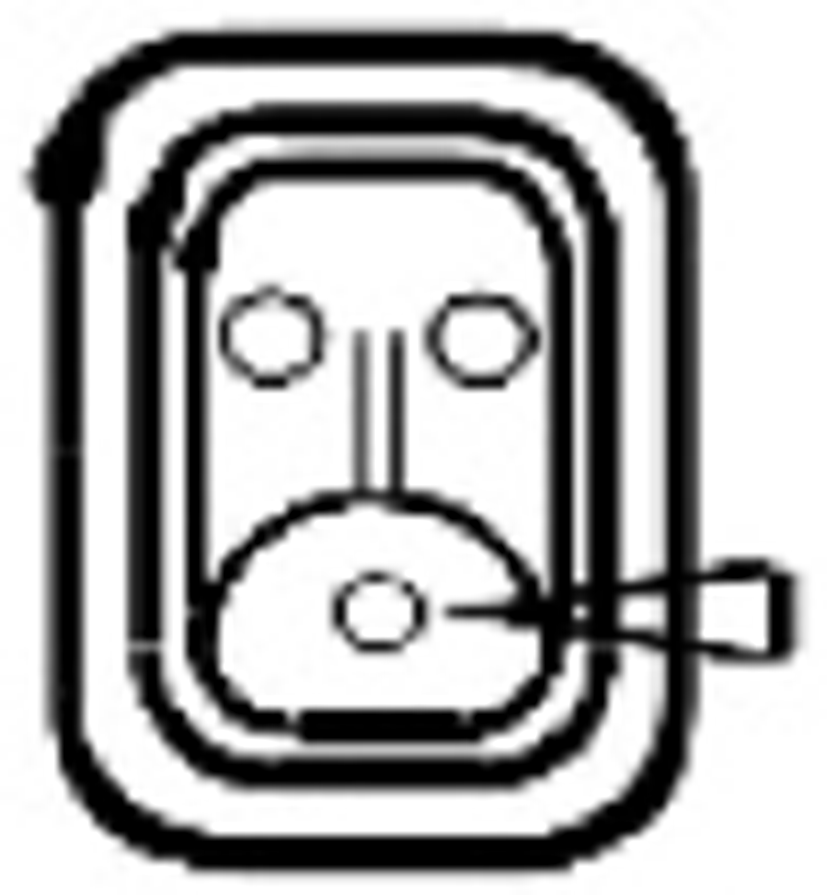
|
‘mouth’ |
Hence, we could easily derive four meanings from this one radical which the Mayans possessed, simply by applying the arrow or other selector/indicator to it. The radicals  and
and  could have been avoided, easing the usability of the system.
could have been avoided, easing the usability of the system.
Hence, in Mayan, too, the arrow has great potential to increase the number of meanings derived from a radical.
Blissymbolics is a project initially created by Charles K. Bliss,9 and presently with devotees, users, and an official organization, Blissymbolics Communication International. Blissymbolics uses an indicator resembling a wedge to point to specific parts of radicals in order to derive specific meanings, e.g., Table 6:
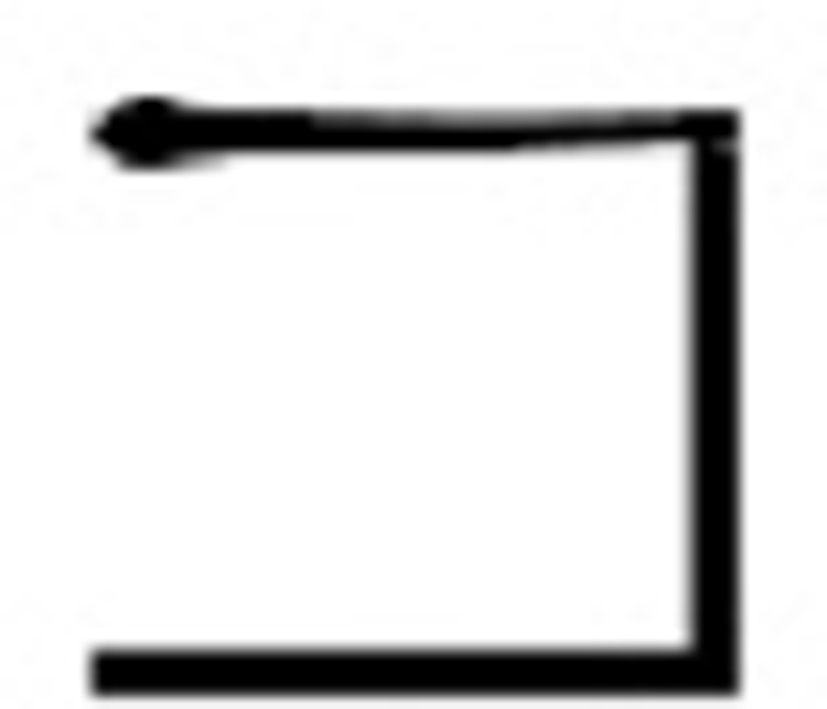
|
‘room’ (Sutton 2017: 120) |
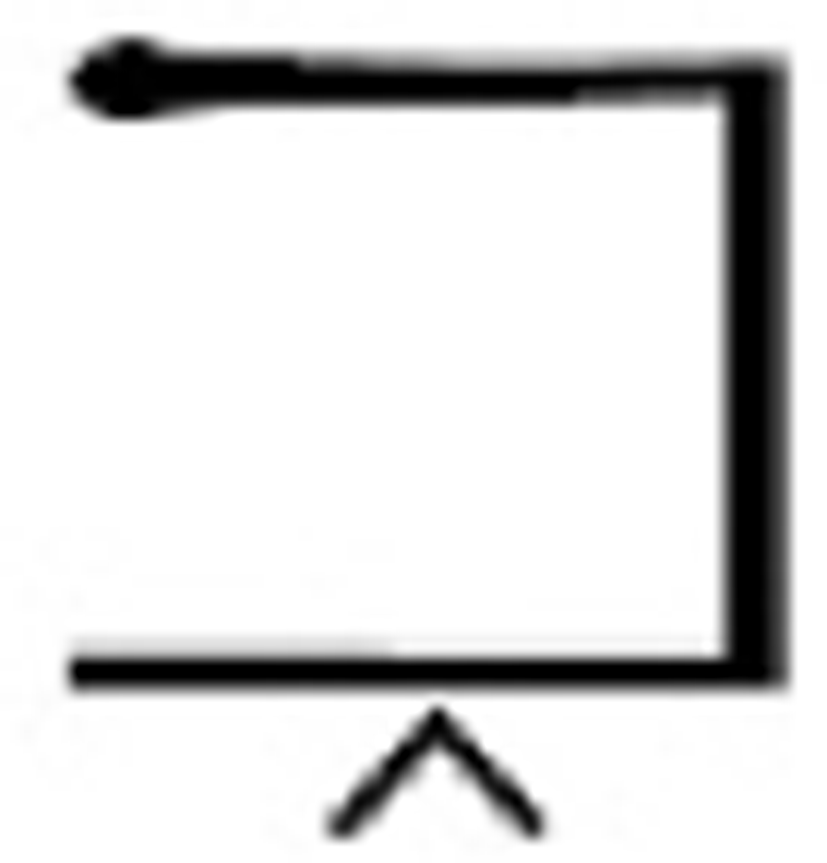
|
‘floor’ (Sutton 2017: 66) |
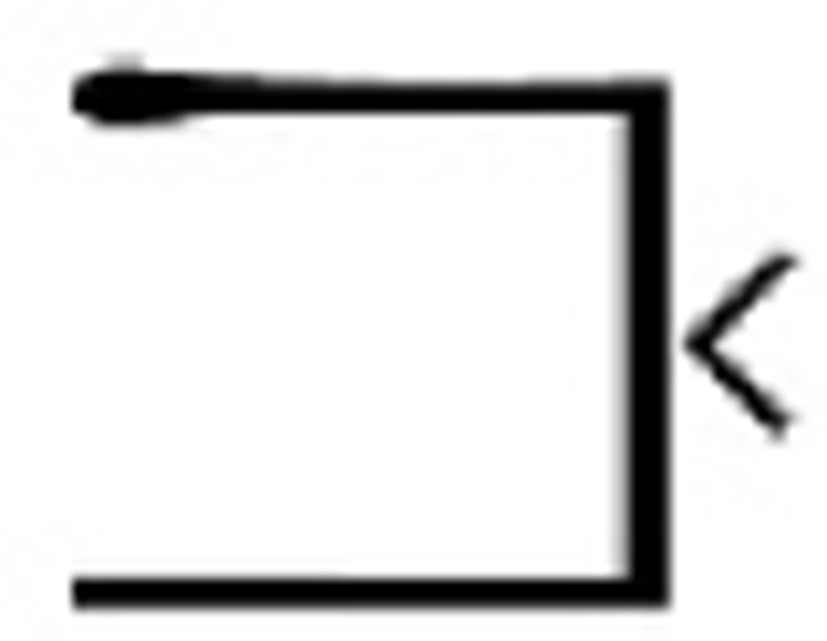
|
‘wall’ (Sutton 2017: 149) |
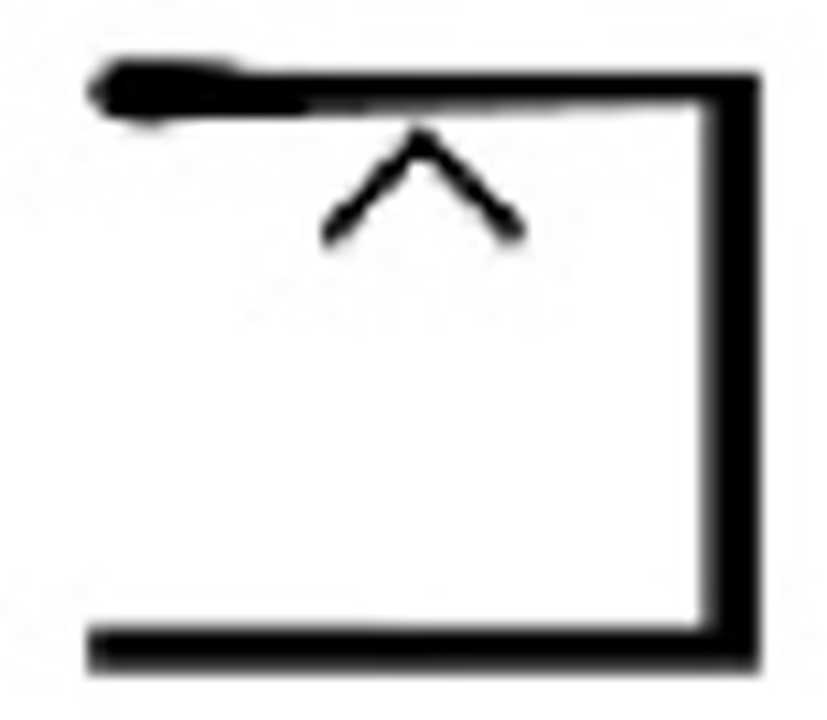
|
‘ceiling’ (Sutton 2017: 39) |
Regarding this use of an indicator, Blissymbolics is a good example of the principle I am advocating.
3. Relatively Few Radicals but Many Derivations and Combinations: Radical-Disqualifiers
The term “radical” as used in the field of semantic writing refers to a basic sign whose meaning may be modified by additional signs or marks (Lodowyck 1647: 7, Wilkins 1668: 324).10,11
There are two possible advantages to having fewer, rather than more, radicals. One is that this will be easier on the memory; The other is that having fewer signs which must combine to represent all other meanings forces the system to be more descriptive, which according to Descartes (1629), Leibniz (Blackburn 2008), and others12 will promote comprehension, and help users see the world more clearly. Descartes states this explicitly (italics mine):
‘And if someone were to well explain what are the simple ideas in the human mind of which all their ideas are composed … I would hope then for a universal language easy to learn, pronounce, and write, and most importantly to aid in the judgement, representing so distinctly all things, so as to make it next to impossible to misunderstand … through the means of which language could the peasants better judge the truth of things than can the philosophers at present…’ (Descartes 1629)
Not only was Descartes proposing a spoken universal language, but also a universal writing based on symbols:
‘…One could adjoin to this an invention, as much for composing the primitive words … as for their characters … And as one can learn in a day to name all the numbers up to infinity, and to write them [for speakers without a common language with the writer, but who are in common familiar with Arabic numerals] … that one can do the same of all the other words necessary to express all the other things which enter into the minds of humans.’ (Descartes 1629).
Leibniz called the principle that a small number of basic ideas combine to form all others The Alphabet of Human Thought (Wierzbicka 1993: 24–29).
As I previously mentioned, to illustrate, consider that one might at first imagine coining a radical for each thought, concept, idea or meaning; Quickly, one realizes that this is going to be absurd, that '#2 Phillips-head screwdriver’ is too specific to deserve its own radical, but should be described by multiple characters.
How many basic concepts are there in the universe? I posit that, in theory, the entire universe could be described in binary code! A binary representation for a semantic-writing system would not, however, be practical, as the representations of things would be much too long. On the other hand, having too many radicals would be both a strain on the memory and would miss the goal of users’ enlightenment by virtue of most expressions’ being mini-definitions, as Leibniz envisioned by constructing a real character based on his Alphabet of Human Thought. Therefore, there must be a balance between too few and too many radicals, or basic symbols, in a semantic-writing system.
How do we arrive at this balance? This has been a major question since the times of Descartes and Leibniz, both of whom supposed the small set of basic thoughts to be hard-wired in our brains (Wierzbicka 1993: 25, 28); Joining those pursuing this research for the sake of semantic writing are also researchers in lexicography, semantics, cognitive science, cultural anthropology, philosophy, and general linguistics as well, such as Wierzbicka (1993: 24–29), who has sought this set of semantic primitives over much of her career. Some humor is found in the strained efforts to reduce the infinity of thoughts to a small number of basic building-blocks, as Père Noël’s defining of “light” as ‘a luminary movement of luminous bodies’ (Wierzbicka 1993: 27) or Humboldt’s assurance that the set of semantic primitives “‘can be sought and really found.’ But he did not say how they can be found or even how one can start looking for them.” (Wierzbicka 1993: 29)!
My response to this difficult question is more particularly directed toward the creating and/or revising of a real character than toward the discovery of the Alphabet of Human Thought, though I do hope it is not incompatible with this latter effort. My response is that we need criteria to determine whether a concept deserves its own radical, or whether it should be represented by a derivation of a radical or combination of radicals; toward this end, I offer below a list of “disqualifiers”, and enumerate and describe them.
This disqualifier states that theta-roles should be represented in relation to their actions or states. Therefore, tools, machines, means, subjects, objects, results, organs of the body with definite purposes, and at least some job-descriptions should not have their own radicals, but be defined and described in relation to their action. Spoken languages do this to some extent, but may not be consistent: Consider that a refrigerator is a machine which refrigerates, the “-or” showing that it is the performer/subject of the action/verb “refrigerate”; However, “television” is not related to “televise” in the same way, and “truck” is used for both the machine and the action; Hence, we cannot expect consistency. Yet if we consistently define tools, machines, doers, done-to’s, etc. in a semantic-writing system by relating them to their actions, we can use the same radical or string of radicals for them as we use for their actions or states, thus greatly reducing our memory-burden. Likewise for state-radicals: We can derive the theta-roles ‘liker’ and ‘(person or thing which is) liked’ as well as the verbs ‘like’ and ‘be liked’ from the same radical.
To demonstrate, the character 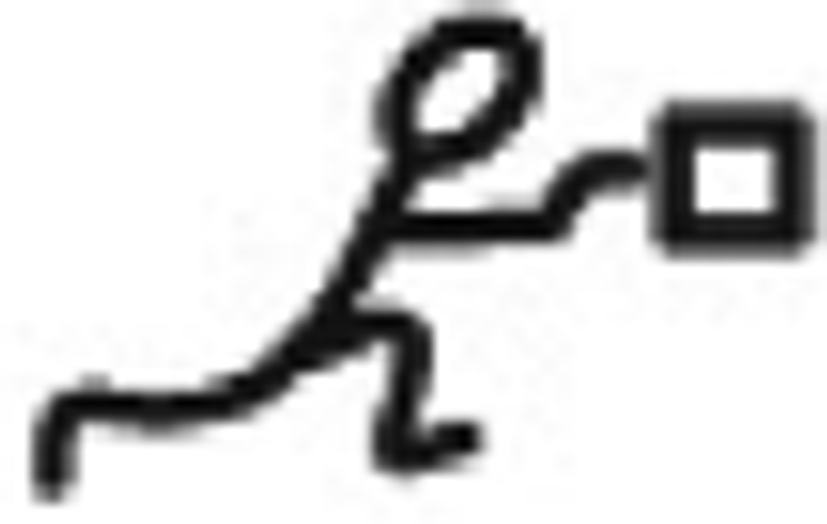 ‘pushing’ in Pictopen, a project by Juan M. Garay of Spain, presents the Θ-roles of subject/performer and done-to/object (Garay 2015). In the Table 7, I have added arrows to this Pictopen character to derive additional meanings (Table 7):
‘pushing’ in Pictopen, a project by Juan M. Garay of Spain, presents the Θ-roles of subject/performer and done-to/object (Garay 2015). In the Table 7, I have added arrows to this Pictopen character to derive additional meanings (Table 7):
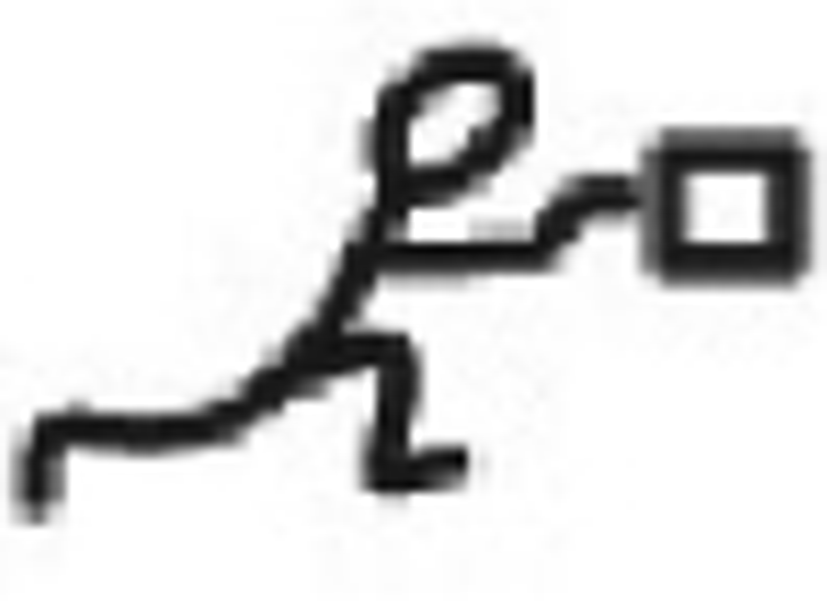
|
‘any action of pushing / being pushed’13 |
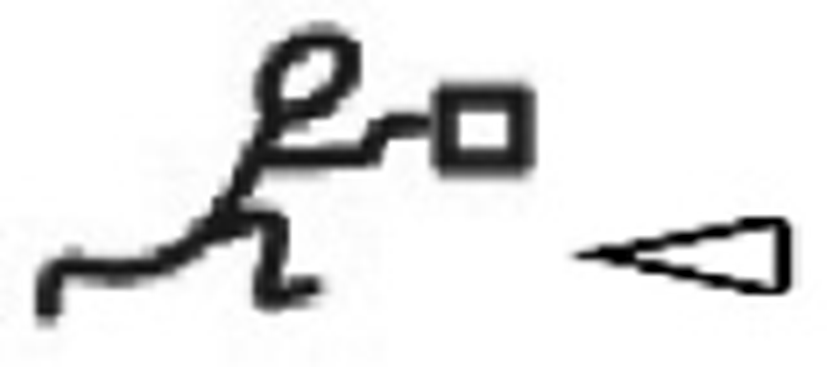
|
‘any person or thing which pushes; push-er’14 |
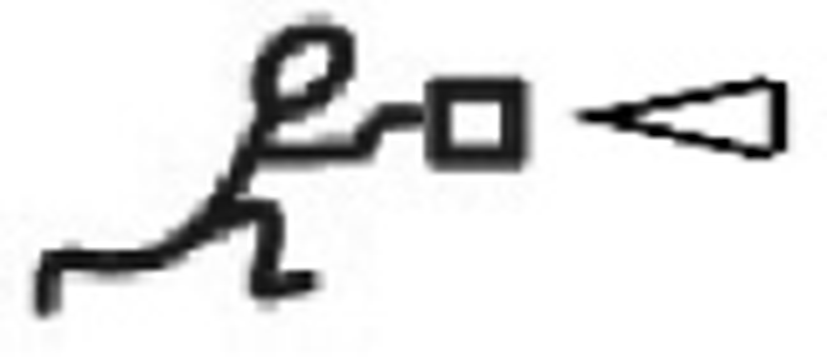
|
‘(any person or thing which is) pushed’ |
This use of arrows or other selectors allows us to access the roles of the action, ‘push-er’ and ‘pushed’, using the same radical.
Alternatively, we could have separate characters for ‘performer’, ‘done-to’, etc., and use them together with action-radicals; That is, if we had a character for ‘doer’/‘performer’/‘agent’/‘subject’, for example 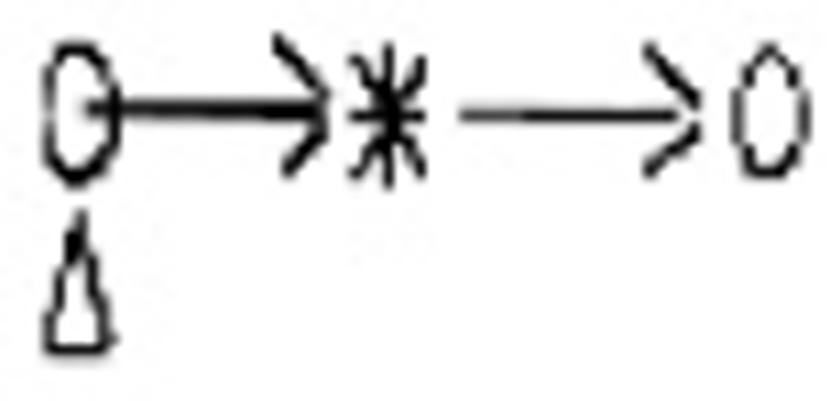 , literally ‘person or thing which successfully directs energy out toward a goal’, we could combine it with ‘push/be pushed’ from Pictopen instead of using an arrow, perhaps as:
, literally ‘person or thing which successfully directs energy out toward a goal’, we could combine it with ‘push/be pushed’ from Pictopen instead of using an arrow, perhaps as:  , literally ‘any person or thing which successfully directs energy out toward a goal, associated with the action of pushing/being pushed; any push-er’. However, there are at least two advantages of using arrows or selectors to select thematic roles from the radical rather than using such external representations of the theta-roles:
, literally ‘any person or thing which successfully directs energy out toward a goal, associated with the action of pushing/being pushed; any push-er’. However, there are at least two advantages of using arrows or selectors to select thematic roles from the radical rather than using such external representations of the theta-roles:
-
There is less mental processing when using selectors to point to roles which are part of the radical, as they are obviously and intuitively integrated as part of the action;
-
Especially for state-radicals, it may be difficult to decide what the subject and object are: Consider that in English, the subject-pronoun is used with the verb “like”, while in Spanish, the object-pronoun is used with the verb “gustar” to express the same concept.
Many characters from various projects/systems do not show these theta-roles, or all of them, at least not in every radical. In Table 8, I am going to compare ‘seeing’ in Bliss, Elephant’s Memory by Timothee Ingen-Housz, LoCoS by Yukio Ōta, Nobel by Milan Randić, and Pictopen. Bliss, LoCoS, Nobel and Pictopen simply use an eye for ‘seeing’:

|
‘see’/ ‘look’/ ‘watch’ | Bliss (Sutton 2017: 124). The wedge atop the eye makes it into a verb. Neither ‘see-er’15 nor ‘seen’ is included in this character. |
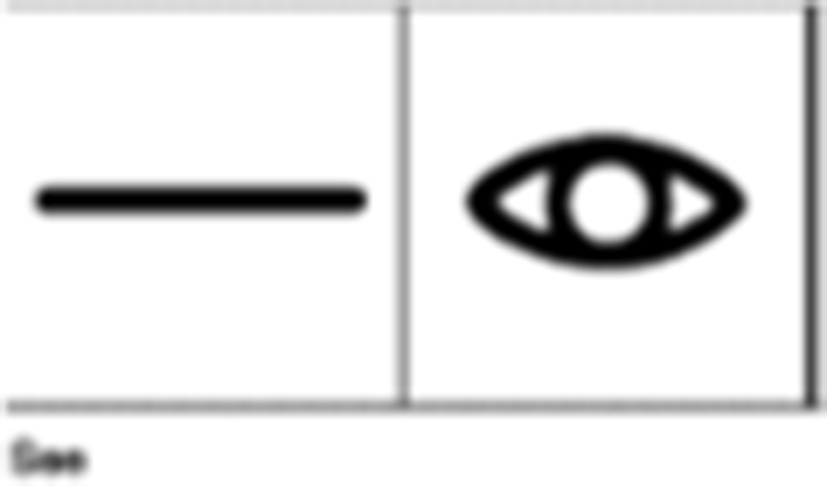
|
‘see’ | LoCoS (Aaron Marcus and Associates 2007: 9). The horizontal bar to the left of the eye makes it into a verb. Neither ‘see-er’ nor ‘seen’ is part of the character. |
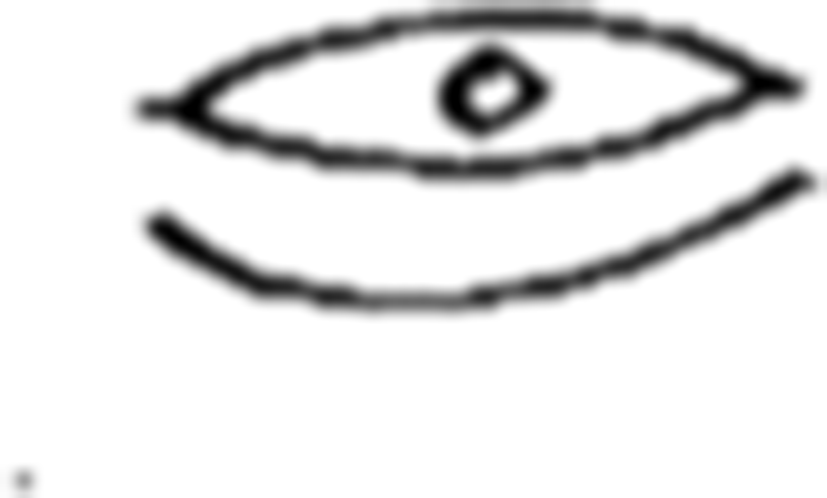
|
‘view’ | Nobel (Randić 2009: 80). Neither ‘see-er’ nor ‘seen’ is included in this character. |
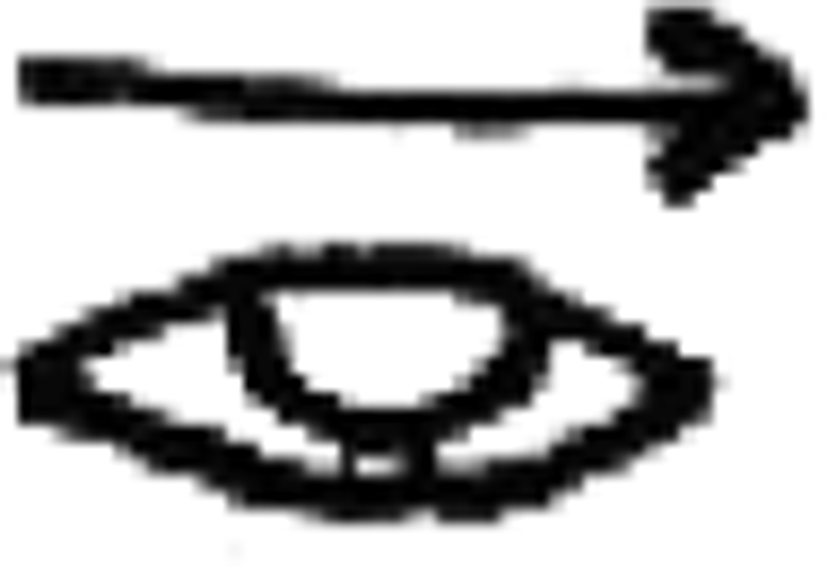
|
‘to see’ | Pictopen (Garay 2015). The arrow makes it an infinitive. Neither ‘see-er’ nor ‘seen’ is represented in this character. |
On the other hand, Elephant’s Memory does include elements representing the subject/agent/doer, though not the object/patient/done-to (Table 9):
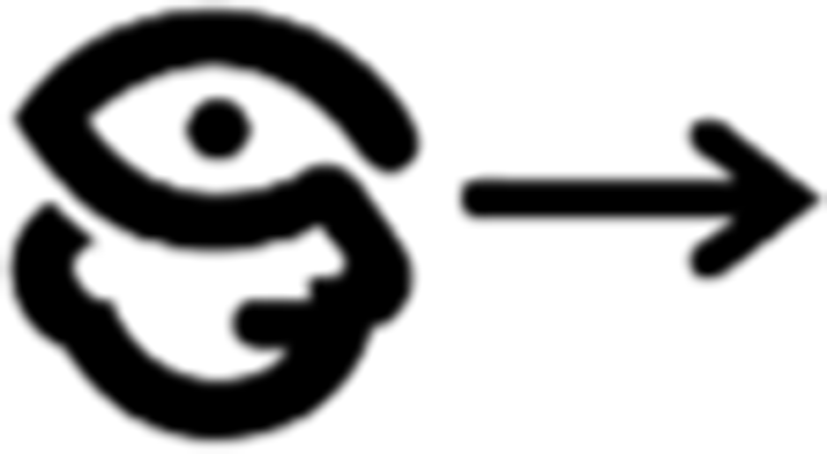
|
‘see’ | Elephant’s Memory (Ingen-Housz 1993: 19). ‘See-er’ is available, as the eye is part of a head, which could be indicated with an arrow or other selector. But the object ‘seen’ is not available as part of the character. |
If a square or circle or some other form representing the object were added to the above character from Elephant’s Memory, we could evoke from it not only ‘see-er’ but also ‘seen’, and in addition ‘eye’ in the sense of ‘organ which is the means of seeing’ (Table 10):
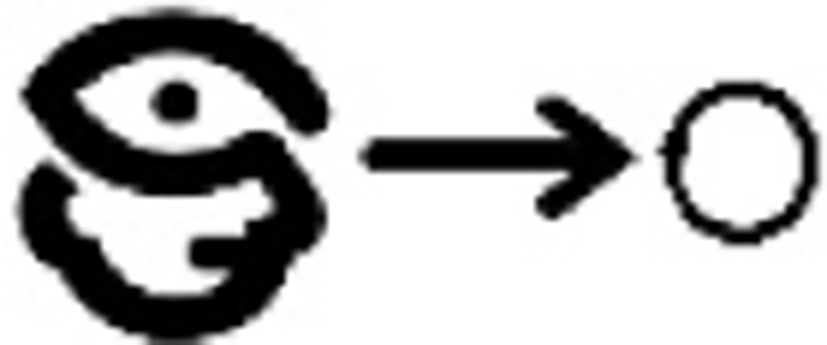
|
‘any action of seeing/being seen’16 |
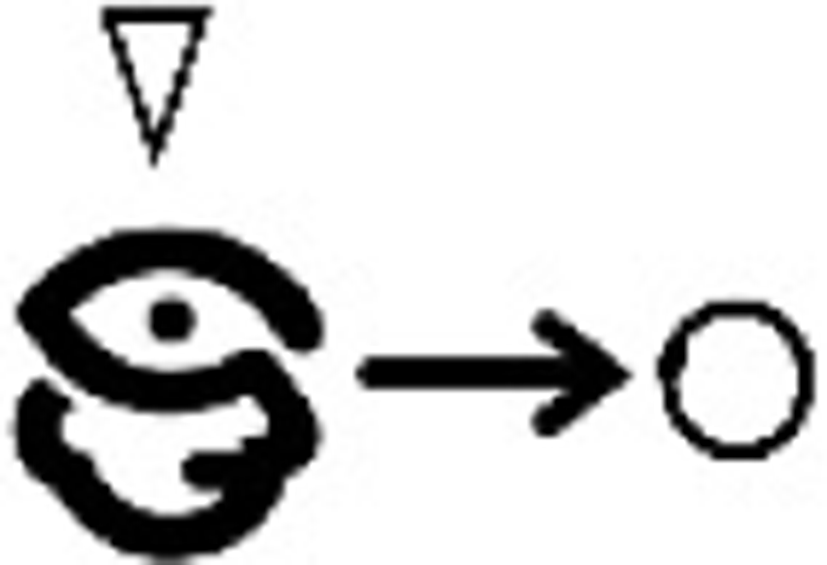
|
‘eye’ in the sense of ‘organ which is a means of seeing’ |
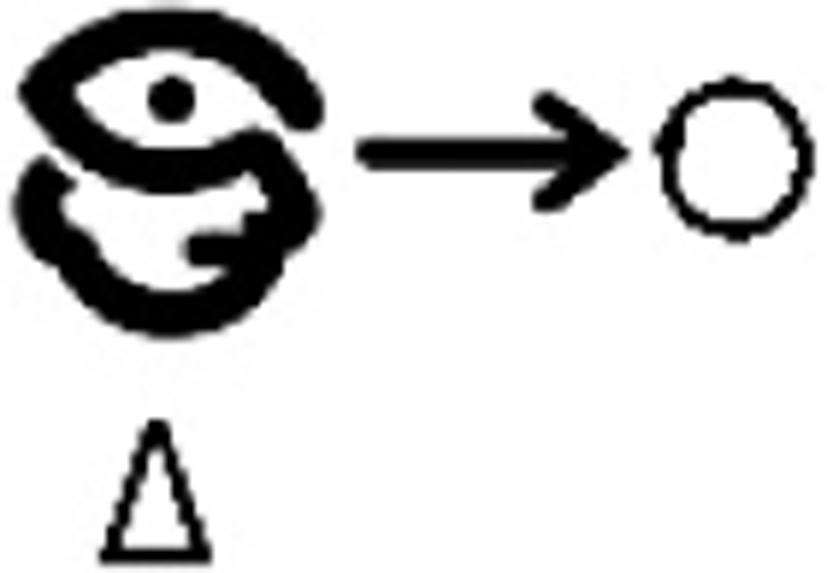
|
‘any person or animal which sees; see-er’ |
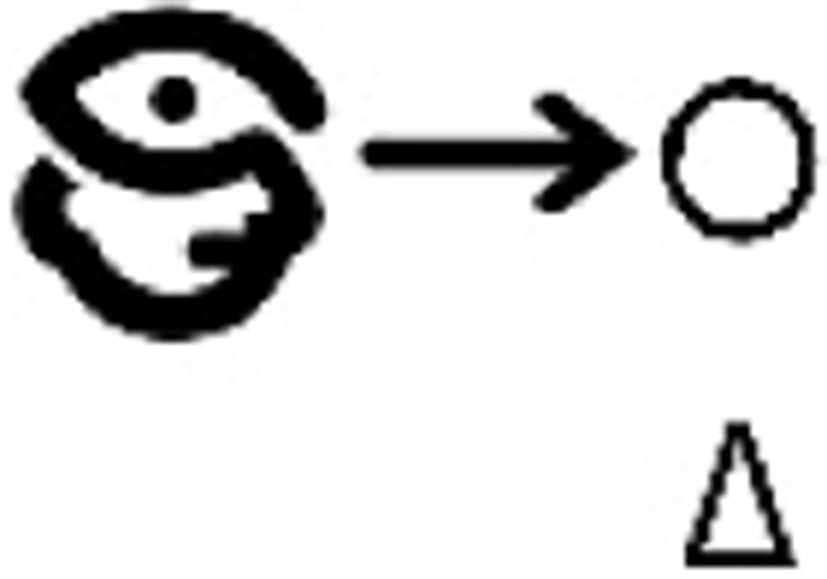
|
‘(any person or thing which is) seen’ |
We have seen subjects, direct objects, and means. What about an indirect object? In order to show a radical with both direct and indirect objects, I show here a character I myself created, due to the unavailability of such a radical in the other systems (Table 11):
We have here in the above schematic-like radical a way to represent the giver, the thing given, and the person given to.17
According to the disqualifier of action-precedence, when we create semantic-writing representations for machines, we first ask what they are designed to do, e.g., maintain a low temperature, and then ask how they differ from other machines with a similar function, e.g., air-conditioner versus refrigerator versus freezer. The functions of these are similar, yet still different, so we can keep these machines apart by naming them after the description of their functions: An air-conditioner reduces the temperature of a human-occupied area; A freezer reduces to freezing the temperature of an enclosure of food and drink; A refrigerator reduces to cold but not freezing the temperature of an enclosure of food and drink. We need to nail down the definitions of machines based on their differing functions; Then we can represent them based on these definitions.
Note that we need to consider the primary intended functions when we name machines and tools: Consider that a clothes-drier may heat up a room in winter, which may be desirable; However, that is not its intended function, and in summer, this is likely undesirable.
The fewer radicals we have, the easier on our memories, but the harder on our mental processing: When creating or revising a semantic-writing system, this is a tight-rope we walk. A creator or revisor of a semantic-writing system who decides not to follow my suggested disqualifier of action-precedence might consider icons such as  ‘land-vehicle’,
‘land-vehicle’,  ‘watercraft’, and
‘watercraft’, and  ‘aircraft’ from Symbola font, which symbols, at a cursory glance, require no mental processing, being instantly recognizable. But I would urge such a creator or revisor who dismisses my appeal for an action-precedence radical-disqualifier to set up in its place some other parameters or principles so as to prevent a mass proliferation of symbols, overstraining the memories of the system’s users to the point of infeasibility; Admittedly, the three characters
‘aircraft’ from Symbola font, which symbols, at a cursory glance, require no mental processing, being instantly recognizable. But I would urge such a creator or revisor who dismisses my appeal for an action-precedence radical-disqualifier to set up in its place some other parameters or principles so as to prevent a mass proliferation of symbols, overstraining the memories of the system’s users to the point of infeasibility; Admittedly, the three characters  ,
,  and
and  , though violating my action-precedence disqualifier, do not appear to pose a burden to the memory, but how many thousands more icons for machines, tools, organs of the body would join them? What about specific types of land-vehicles: Would you have different icons for sedans, station-wagons, vans, SUV’s, busses, eighteen-wheelers, etc.? Or would you follow
, though violating my action-precedence disqualifier, do not appear to pose a burden to the memory, but how many thousands more icons for machines, tools, organs of the body would join them? What about specific types of land-vehicles: Would you have different icons for sedans, station-wagons, vans, SUV’s, busses, eighteen-wheelers, etc.? Or would you follow  with strings of descriptors to distinguish among these various subtypes of land-vehicles? What about actions, such as sending by truck? Without action-precedence, you might have to build the action on the machine rather than vice-versa. And again, icons are often just pictures rather than definitions encoded into symbols.
with strings of descriptors to distinguish among these various subtypes of land-vehicles? What about actions, such as sending by truck? Without action-precedence, you might have to build the action on the machine rather than vice-versa. And again, icons are often just pictures rather than definitions encoded into symbols.
My approach of representing the cast of types of vehicles is to relate them to their action, which is moving or carrying, and compare and contrast them to forge definitions capturing each one in opposition to the others. Once we have defined them rigidly enough, then we can attempt to encode the definitions via semantic-writing symbols. In order simply to forge definitions, we may need to begin by bombarding ourselves with questions such as, in this case: How do we define “vehicle”? We know it is related to movement, but does it have to move itself, as a modern motorized vehicle, or can we count horse-buggies, canoes, bicycles and hot-air balloons? Does it have to carry at least one human, or may we include the unmanned rovers on Mars? Many modern vehicles completely contain the human(s), but that is not the case with a motorcycle, so is the idea of containing not part of the definition?
Let us suppose we define “vehicle” as a human-made platform or container which moves itself. Further, suppose we use a horizontal line for the platform, and dashed lines for the sides and top, since they may or may not be present, and an arrow pointing to one corner, in an effort to select the entire set of lines instead of the top or one side, and then a circle on the platform indicating ‘any person or thing’: . For the idea of ‘self-moving’, we could consider ‘moving’ as an exchange of positions by any person or thing, but we would still need a way of showing control of this action, or else it would appear to be ‘any person or thing which is moved’. A control-loop around the exchange of places is a possible device to indicate the subject of it, and since this machine moves itself, it is subject and object, thus needs arrows under both Θ-roles, as: 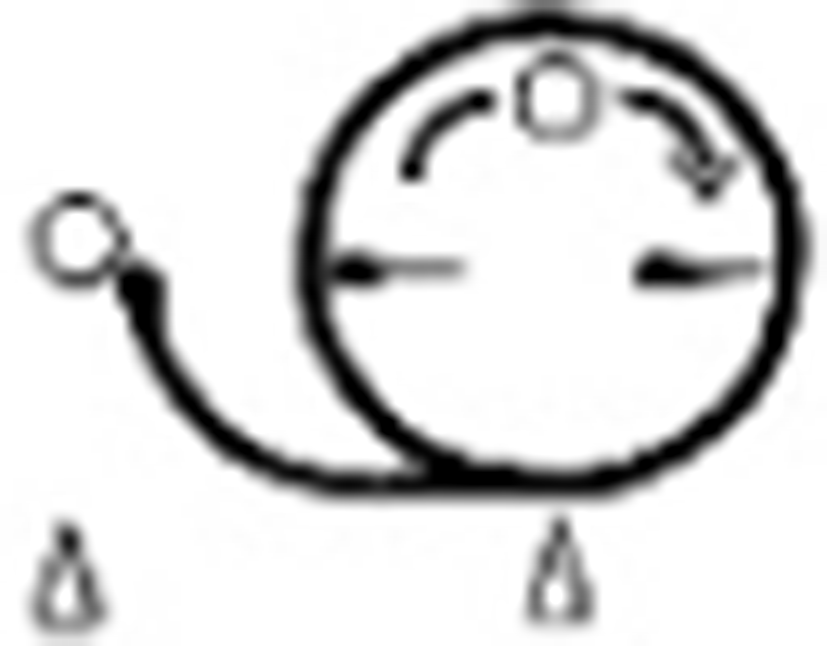 . So I posit that
. So I posit that 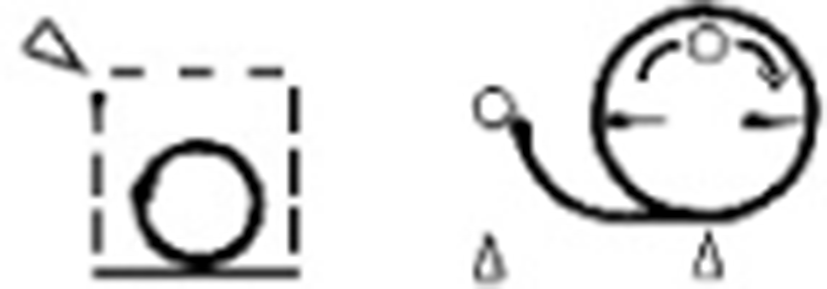 could be used to represent ‘any platform or container of any person or thing, which moves itself’. On the spectrum of pictographic/ideographic, that is not terribly pictographic: It does not look like a truck, tugboat or jet, but then again ‘vehicle’ is an abstract concept: How would you use icons like
could be used to represent ‘any platform or container of any person or thing, which moves itself’. On the spectrum of pictographic/ideographic, that is not terribly pictographic: It does not look like a truck, tugboat or jet, but then again ‘vehicle’ is an abstract concept: How would you use icons like  ,
,  or
or  to represent ‘vehicle’? This is another advantage of trying to define concepts, and then encode the definitions as a means of representing them semantically, rather than simply drawing pictures of the concepts: when the concept is vague, we can use a representation which is vague.
to represent ‘vehicle’? This is another advantage of trying to define concepts, and then encode the definitions as a means of representing them semantically, rather than simply drawing pictures of the concepts: when the concept is vague, we can use a representation which is vague.
There are numerous additional points related to the action-precedence disqualifier to be made and argued, such as how to cope with undesirably long expressions, how to treat items such as ‘computer’, which seem to have many functions of equal importance, and what to do if for some reason, the function is unknown (as a mysterious artefact uncovered from a lost civilization). In the interest of keeping this article brief, however, they will have to wait; An entire article could easily be devoted to just the matter of the action-precedence disqualifier.
In summary, the action-precedence disqualifier means that tools, means, machines, organs, subjects, objects, results, and at least some job-descriptions should not have their own radicals, but be represented by the radical for their actions, with a selector indicating the person or thing which performs, results, or is performed on. Representing tools, machines, organs and job-descriptions by relating them to their actions is reliable; The possible disadvantages are balanced out by advantages; In addition, we gain a mini-definition of the things represented thus, as opposed to a mere silhouette of their likeness. This is one of the goals which some of the 1600’s proponents wished for, and which I also wish for, in the belief that this will help us attain a clearer view of the universe. In addition, it results in a lower memory-burden for the user of the system, which is critical to the success of a purely semantic-writing system.
This disqualifier ensures that opposites such as ‘love’/‘hate’ and ‘hot’/‘cold’, as well as any intermediate degrees, have to share the same radical, which is modified for pole and degree. Or, alternatively, the radicals can be slightly different in a predictable and recognizable way which does not mandate rote memorization.18
Before examining these methods in more detail, I wish now to point out that there are two types of opposites, which I refer to as “graded” or V-shaped and “mirrored” or X-shaped. Here are some examples to illustrate (Table 12):
| SHAPE | DEGREE |
|---|---|
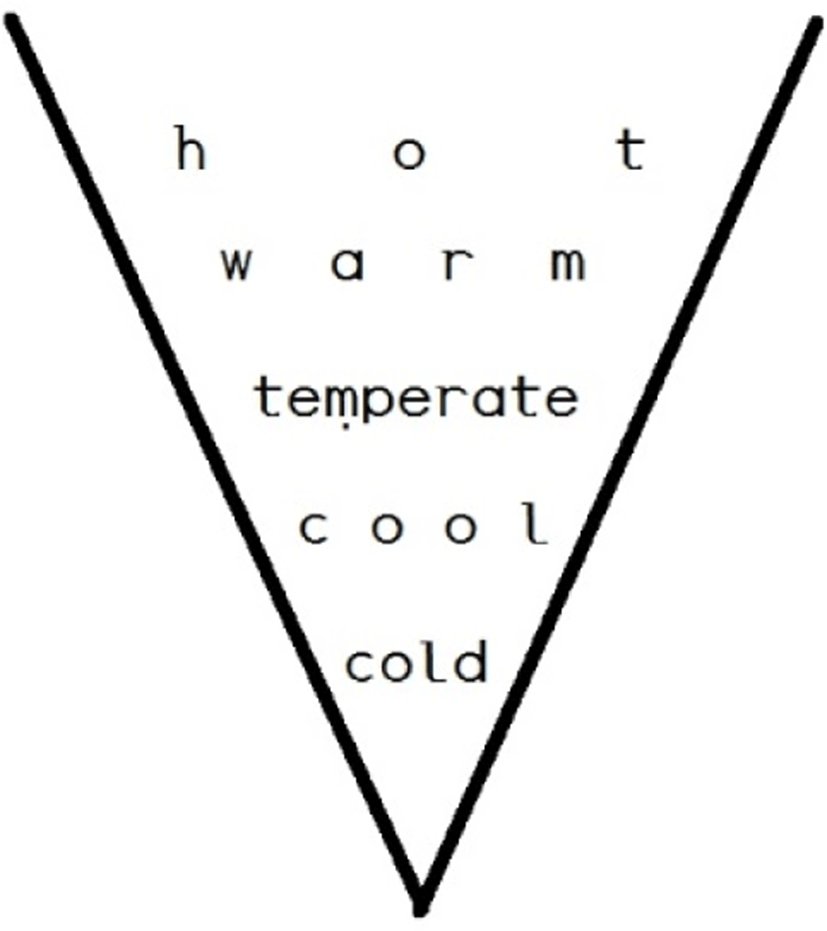
|
--- great |
| --- moderately great | |
| --- moderate | |
| --- moderately low | |
| --- low |
You may remember from your early science-education that cold is just a lesser degree of heat; Scientists believe that if an object were cooled enough, eventually there would be no heat: absolute zero (Editors of Encyclopaedia Britannica, 2021). Hence, cold is not an equal opposite of hot: Unless scientists discover “anti-heat”, then heat has no true opposite. This is what I mean by a graded opposite; I visualize this concept as V-shaped with the bottom tapering to nothing, and gradation-marks up and down it.
In contrast, consider the mirrored opposite, which I visualize as X-shaped (Table 13):
| SHAPE | DEGREE |
|---|---|
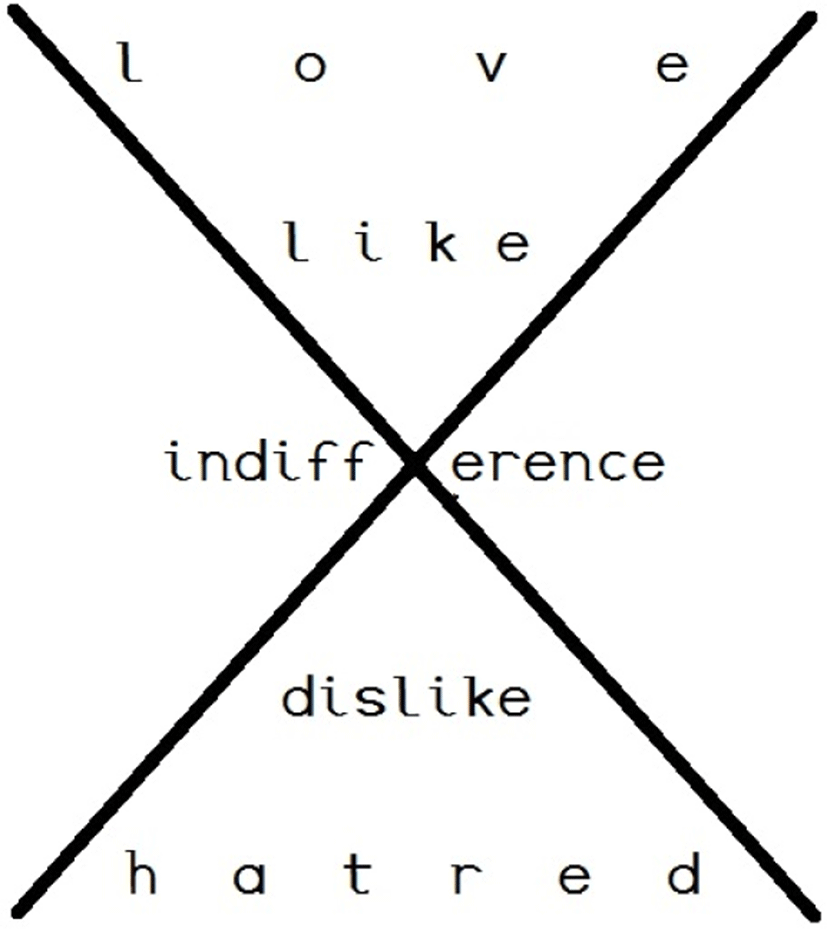
|
--- positive strong |
| --- positive moderate | |
| --- zero-value | |
| --- negative moderate | |
| --- negative strong |
Unlike hot and cold, love and hate are “true opposites” in that we perceive of them as possibly being of equal strength yet of opposing poles. I visualize these mirrored opposites as X-shaped with one pole at the top, and the other at the bottom, with the “waist”, or midpoint, having a value of zero, and with moderate points between the midpoint and the poles.
The distinction between graded and mirrored opposites is relevant to this discussion: Outside of the field of real characters, when we discuss negation, we sometimes refer to the zero-value, but at other times to a true negative, and do not seem to notice that we are using “negation” for two different, though related, concepts. It is important for us to recognize graded versus mirrored opposites for this discussion and for the ensuing analysis of the eight methods of representation listed below, as will soon become evident.
In case the reader should think this distinction too technical and not reflective of how speakers think or languages behave, consider such a primal concept as ‘empty’, quite plainly of neutral- or zero-value. Now consider the similarly primitive concept of ‘ugly’, a kind of repulsion and true opposite of ‘handsome’ or ‘beautiful’, which are attractions. Does that contrast of two deeply felt concepts not seem compelling? ‘Empty’ is just running out of ‘full’, while ‘ugly’ is actually pushing in the opposite direction of ‘handsome’ or ‘beautiful’: They’re two kinds of opposites; And I suggest this may be felt by all of us at some deep level. As for language’s apparent treatment of neutral and negative, we can observe positive/neutral/ negative sets such as “advantageous”, “not advantageous”19 and “disadvantageous”, in which “not advantageous” refers to something which will not advance one’s goals but perhaps will not go against them, while “disadvantageous” refers to something which will go against one’s goals. Hence, there is sound reason to believe that the ‘neutral’/’negative’ distinction, both conceptually and in terms of linguistic representation, is real.
Nonetheless, if the reader remains unconvinced of the mental, psychological, and linguistic distinction between neutral and negative, the fact remains regardless that we need to examine the negation- and neutralizing-devices of the various authors, and that when we do so, we are thereupon faced with the fact that not all devices can be applied to both neutral/zero and to true negative. Indeed, in semantic writing, there are various proposed devices to mark pole and degree, not all of them fully equivalent:
A slash through the character as a way of signifying neutrality or ‘not’, as  ‘blind’ in Nobel (Randić 2009: 55) or
‘blind’ in Nobel (Randić 2009: 55) or  ‘don’t see’ in LoCoS (Gaul 2019), is one proposal; It is one of the devices used in Nobel, for characters for which it is graphically workable. A slash through the character is intuitive, but only for the zero-value, not for the negative: for negatives, i.e., true opposites, another device seems called for.
‘don’t see’ in LoCoS (Gaul 2019), is one proposal; It is one of the devices used in Nobel, for characters for which it is graphically workable. A slash through the character is intuitive, but only for the zero-value, not for the negative: for negatives, i.e., true opposites, another device seems called for.
Turning a character upside-down to make it opposite is familiar to us in such cases as the upside-down heart meaning ‘hate’, as opposed to ‘love’. This device is also employed in Nobel, including this exact instance 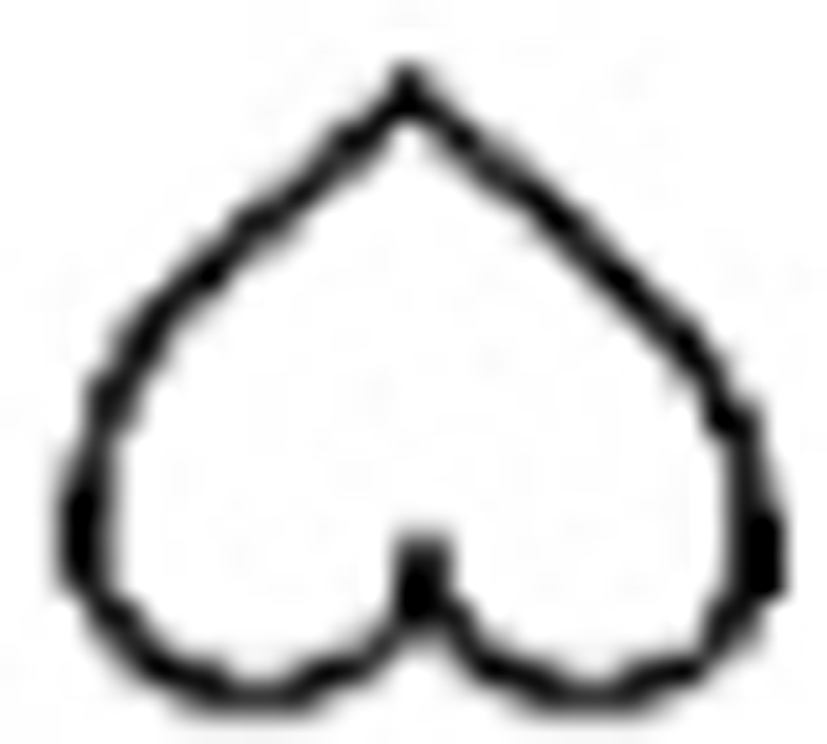 , (Randić 2009: 52).20
, (Randić 2009: 52).20
There are two issues to deal with regarding this device of rotation:
-
How should the zero-, or neutral-, value be represented? Should the character be turned ninety degrees for this,
 for ‘indifference’?
for ‘indifference’? -
Another possible issue would be characters which are top/down symmetrical: These would need to be dealt with in some fashion. The possibility might be pursued of making them deliberately asymmetrical, or I suggest an underscore could be employed for the positive, which when the character was rotated, would become an overscore.
“1/” placed over or before the character. This is yet a third method existing in Nobel. This device seems somewhat less obvious than the other methods. Randić explains that 2 and ½ are reciprocals, representing outcomes of the opposite mathematical operations of multiplication and division, i.e., 1 × 2 = 2; 1 ÷ 2 = ½ ; Therefore, if  is ‘like’, then 1/
is ‘like’, then 1/ should be ‘dislike’. But this appears somewhat convoluted and not very intuitive; I prefer and recommend the other seven methods over this one.
should be ‘dislike’. But this appears somewhat convoluted and not very intuitive; I prefer and recommend the other seven methods over this one.
Both poles, with one marked: This method is illustrated by the Pictopen expressions 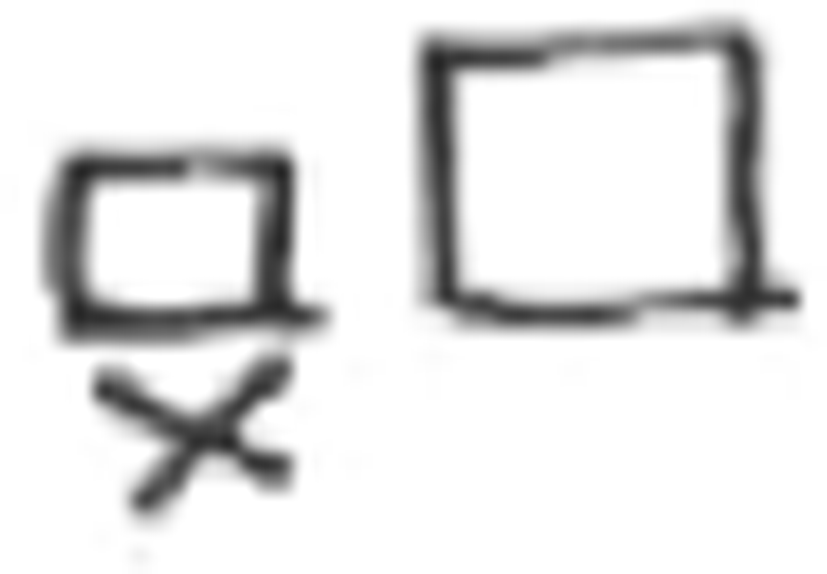 ‘small’ and
‘small’ and 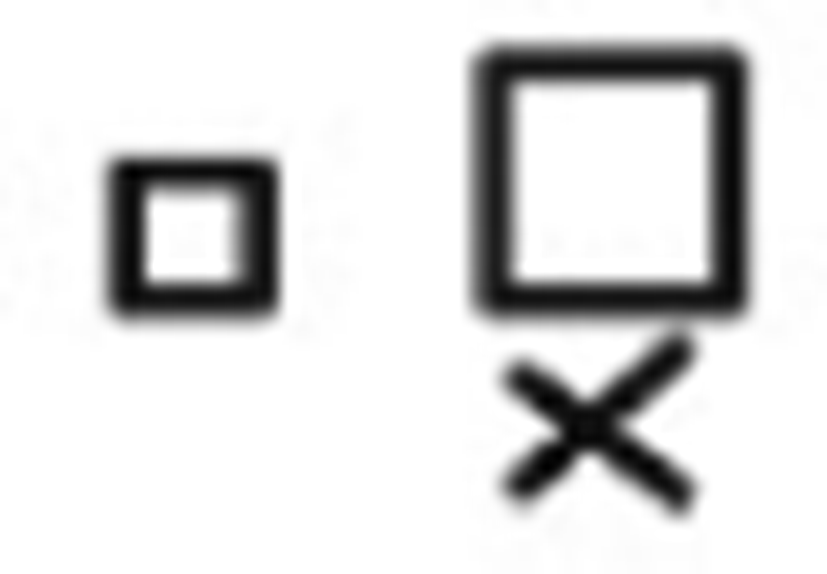 ‘big’ (Garay 2015).21 For the reader, this device is intuitive and clear, but for the writer using a stylus, it would appear somewhat laborious, especially using a square to mean ‘any thing’, as opposed to something quicker to write, like a circle, for that meaning. Another point is that the other degrees, e.g., ‘medium’, need to be represented. A strategy for accomplishing this might be the introduction of degrees in between the poles, under which the X or an arrow or other selector could also be placed, as
‘big’ (Garay 2015).21 For the reader, this device is intuitive and clear, but for the writer using a stylus, it would appear somewhat laborious, especially using a square to mean ‘any thing’, as opposed to something quicker to write, like a circle, for that meaning. Another point is that the other degrees, e.g., ‘medium’, need to be represented. A strategy for accomplishing this might be the introduction of degrees in between the poles, under which the X or an arrow or other selector could also be placed, as 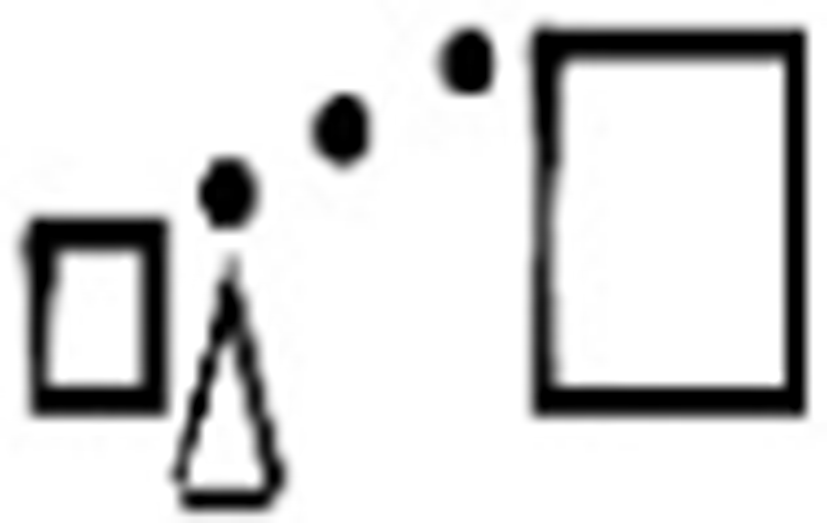 ‘medium-small’,
‘medium-small’, 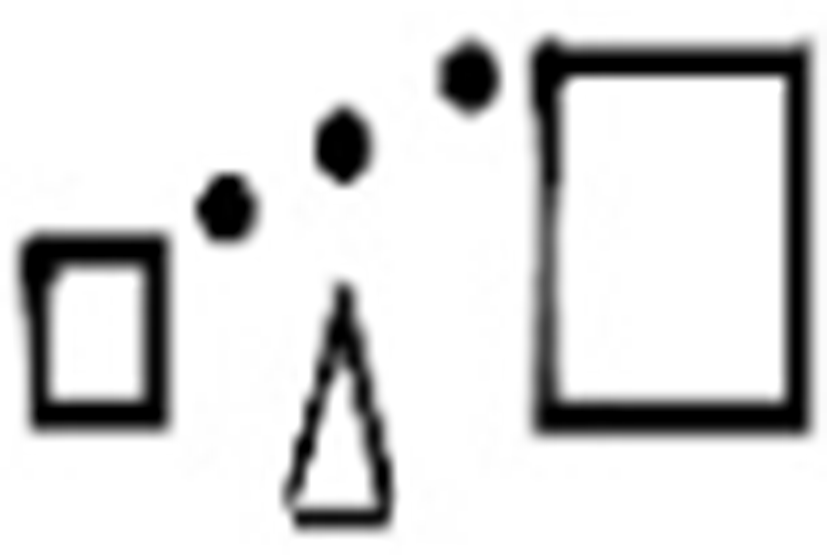 ‘medium-sized’, and
‘medium-sized’, and 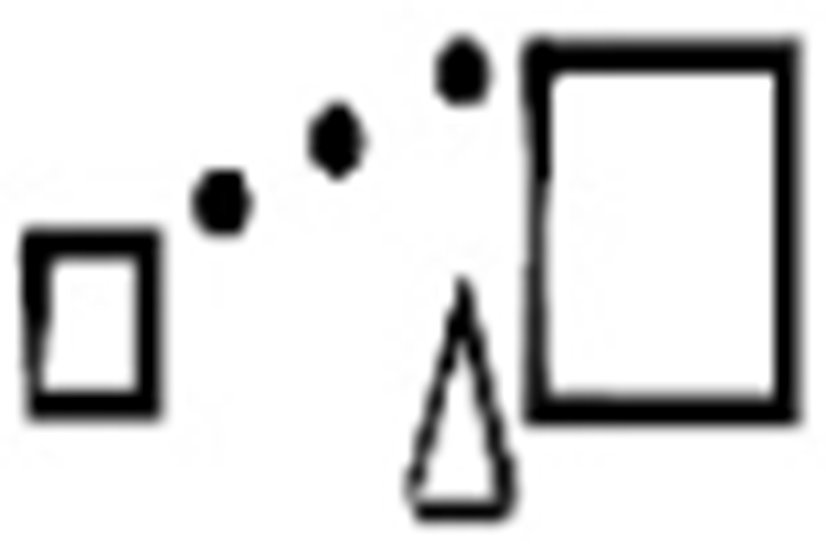 ‘medium-large’ allowing us then to mark intermediate degrees in addition to ‘small’ and ‘large’.
‘medium-large’ allowing us then to mark intermediate degrees in addition to ‘small’ and ‘large’.
LoCoS makes use of arrows, for example with ‘wide’ 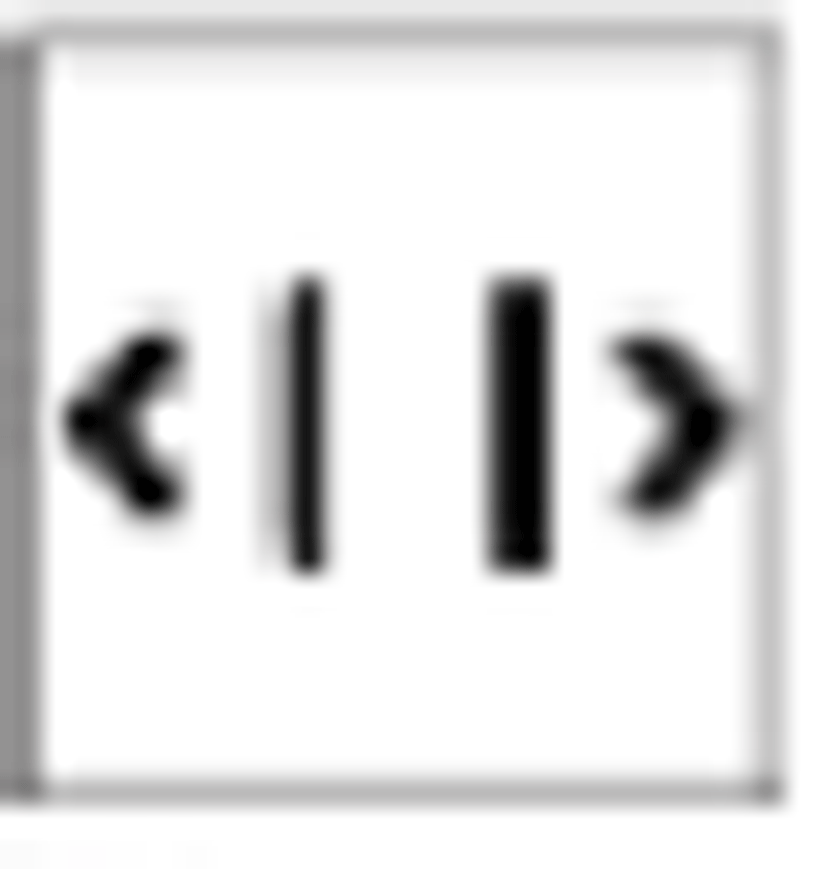 /‘narrow’
/‘narrow’  : (Aaron Marcus and Associates 2007: 13). The pairs of arrows used in LoCoS for ‘wide’/‘narrow’ seem to convey those concepts intuitively, but how many concepts can be treated this way? Would this device be appropriate for ‘hot … cold’ or ‘love … hate’? A second concern is that this device appears to be suitable for toggles like ‘open’/‘closed’, but what if we want to say ‘ajar’ or ‘half-closed’? In addition, it is not clear how this approach would work with mirrored concepts like ‘love … hate’.
: (Aaron Marcus and Associates 2007: 13). The pairs of arrows used in LoCoS for ‘wide’/‘narrow’ seem to convey those concepts intuitively, but how many concepts can be treated this way? Would this device be appropriate for ‘hot … cold’ or ‘love … hate’? A second concern is that this device appears to be suitable for toggles like ‘open’/‘closed’, but what if we want to say ‘ajar’ or ‘half-closed’? In addition, it is not clear how this approach would work with mirrored concepts like ‘love … hate’.
Radicals only slightly different for positive and negative, as per reversed arrows, but not so different as to require rote memorization: An example of this is found in LoCoS ‘go’ 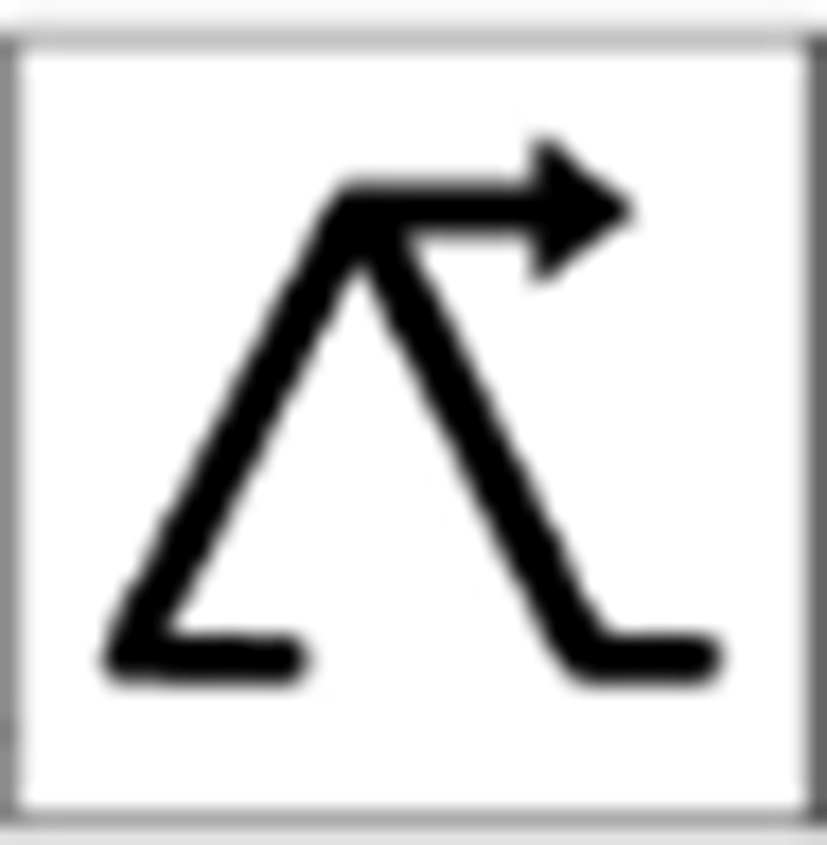 and ‘come’
and ‘come’ 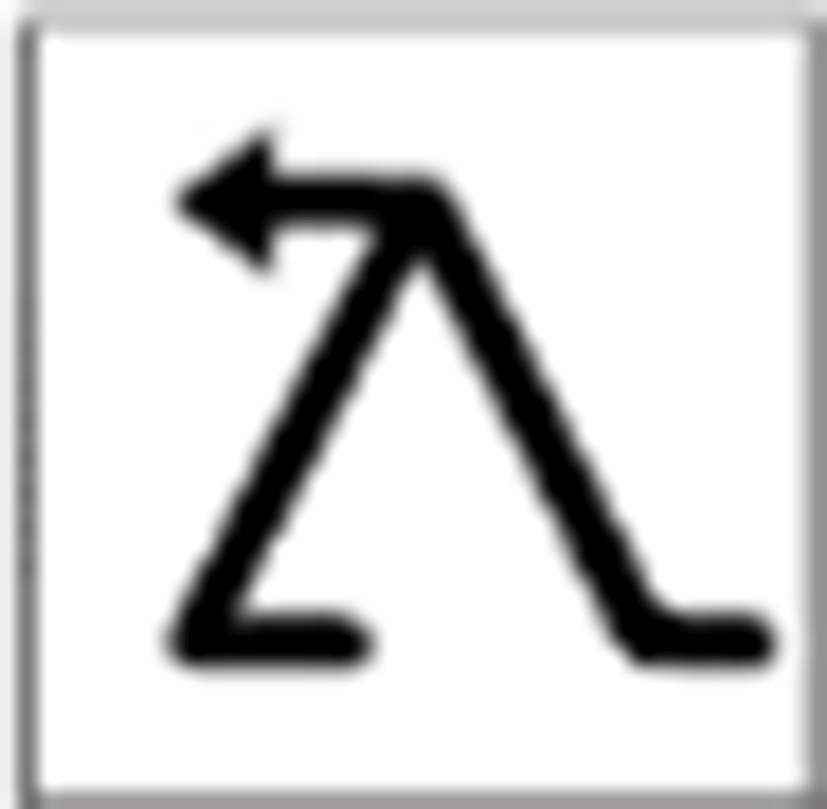 (Aaron Marcus and Associates 2007: 13), in Pictopen ‘go’
(Aaron Marcus and Associates 2007: 13), in Pictopen ‘go’  and ‘come’
and ‘come’  (Garay 2015), and in another, more borderline, case in Elephant’s Memory in ‘day’
(Garay 2015), and in another, more borderline, case in Elephant’s Memory in ‘day’  and ‘night’
and ‘night’  (Ingen-Housz 1993: 25). I say the example from Elephant’s Memory is a marginal example because not only is the sun turned upside-down, but its position relative to the curvature of the earth differs, amounting to two differences. I am sure a learner could deal with this, but I would imagine with every additional difference, slightly more effort on the part of the learner would be required, which raises the question of how we can judge whether the positive and negative radicals are only slightly different, or are too far apart for a learner and user to recognize. This strategy of only slightly differing positive and negative radicals is worth our time investigating.
(Ingen-Housz 1993: 25). I say the example from Elephant’s Memory is a marginal example because not only is the sun turned upside-down, but its position relative to the curvature of the earth differs, amounting to two differences. I am sure a learner could deal with this, but I would imagine with every additional difference, slightly more effort on the part of the learner would be required, which raises the question of how we can judge whether the positive and negative radicals are only slightly different, or are too far apart for a learner and user to recognize. This strategy of only slightly differing positive and negative radicals is worth our time investigating.
Doubling: To show degree, the doubling of characters or of elements of characters is used in both Nobel ‘like’  (Randić 2009: 52) and ‘love’
(Randić 2009: 52) and ‘love’  (Randić: 58), as well as in Blissymbolics ‘dislike’
(Randić: 58), as well as in Blissymbolics ‘dislike’  (Sutton 2017: 54) and ‘hate, hatred’
(Sutton 2017: 54) and ‘hate, hatred’  (Sutton 2017: 75). The use of doubling to represent the higher degrees, e.g., ‘love’ and ‘hate’ versus ‘like’ and ‘dislike’, seems reasonably intuitive, but we need to establish how the zero-value, or neutralization, should be treated.22 Importing one of the other methods, such as slashing or rotating, for the neutral degree might be ways to fill this gap. If slashing, I propose the most intuitive practice might be to feature a positive and negative together, each slashed, for example
(Sutton 2017: 75). The use of doubling to represent the higher degrees, e.g., ‘love’ and ‘hate’ versus ‘like’ and ‘dislike’, seems reasonably intuitive, but we need to establish how the zero-value, or neutralization, should be treated.22 Importing one of the other methods, such as slashing or rotating, for the neutral degree might be ways to fill this gap. If slashing, I propose the most intuitive practice might be to feature a positive and negative together, each slashed, for example 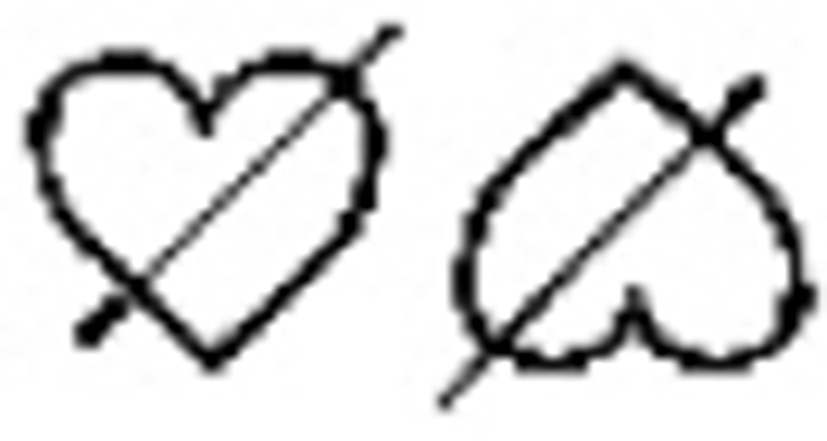 , meaning ‘neither like nor dislike’; ‘indifference’.
, meaning ‘neither like nor dislike’; ‘indifference’.
My proposal, aside from continuing to explore slashing, rotation, doubling and slightly differing radicals, is the use of “gradientials”, separate characters preceding or postceding the radical, showing the radical’s pole and/or degree. I propose that, on the assumption we wish for a semantic writing which attempts to reflect our knowledge of the universe, this calls for two gradientials: One graded, for concepts like ‘hot … cold’ without true opposites, V-shaped; And one mirrored, for concepts like ‘love … hate’ with true opposites, X-shaped. I believe gradientials will be usable in all cases, with none of the issues discussed with some of the other strategies. This method is readily usable for positives, neutrals and negatives, while slashing, rotation, representing both poles and doubling need to be shown capable of this. It is less convoluted and more intuitive than “1/” before or over a character, and it can handle all types of semantic themes, while the arrow-pairs of LoCoS have only been shown so far to work with geometric themes. Also, it remains to be seen whether the approach of slightly different radicals for degrees, such as the reversal of arrows, can be applied to all semantic themes; While the gradiential stands ready to serve here.
A disadvantage of the gradiential, however, is that having one character for the main part of the message, and a separate one to mark pole and degree requires more mental processing than some of the other approaches, which is why we should continue to explore these others. I can envision gradientials as well as one or more of the other methods above co-existing in a system: Perhaps the gradientials could be used with radicals which for some reason could not use the other methods.
Regardless of which method or methods we should choose, using the same, or almost the same, radical for opposites and degrees in between will bring a complete semantic-writing system further into the realm of possibility by reducing the memory-burden of both the writer and the reader. And again, it may help us see the universe more clearly by forcing representations to be mini-definitions.
First, I should define what I mean by “action of change”, as it could be argued that every action involves some form of change if even on the molecular level. If an action can be separated into ‘change’ plus another semantic component, then I consider it an action of change. To illustrate, suppose that, regarding someone’s deciding on a destination for a vacation, we equate ‘deciding’ with something along the lines of ‘changing to knowing what one wants by means of mental activity’. Should we accept this or a similar definition, then we could consider the English verb “decide” an action of change. On the other hand, if the person thinks or reflects for hours, yet does not arrive at a decision, we could say that no noticeable change has occurred, that this is simply an action, not an action of change.23
This section touches somewhat on points made in the last; Nonetheless, a separate disqualifier is presented here. This disqualifier requires actions of change either to be represented by a combination of two radicals, one for ‘change’, plus a second to show the other concept, or alternatively, by one radical which nonetheless still clearly shows ‘change’ plus the other concept in such a manner that the user of the system does not have to memorize the radical by rote, as a unique character.
To demonstrate, suppose we were to use the following radical for ‘occupying/being occupied’: 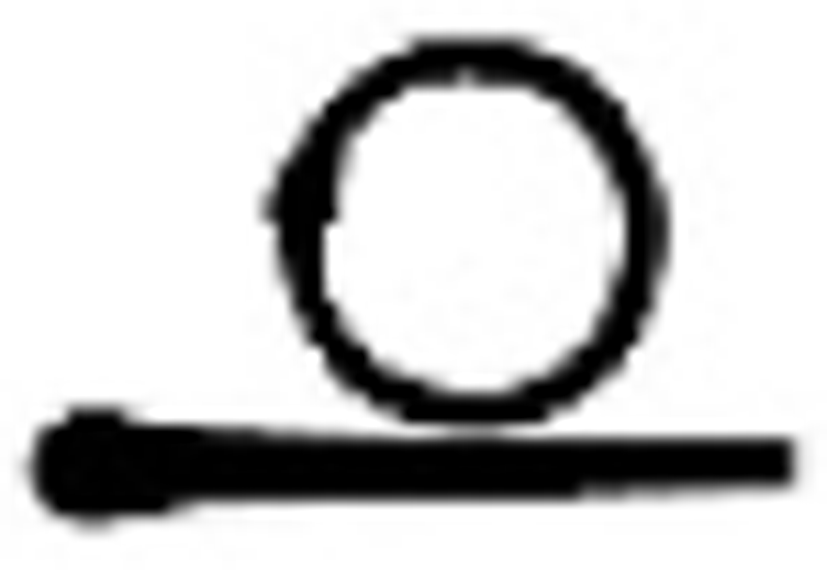 , with the circle representing ‘any person or thing’, and the horizontal line meaning ‘surface’. As movement entails exchanging one occupied place for another, we might consider combining a curved, shafted arrow representing ‘change’ with ‘occupying/being occupied’ to yield ‘moving/being moved/movement’, as
, with the circle representing ‘any person or thing’, and the horizontal line meaning ‘surface’. As movement entails exchanging one occupied place for another, we might consider combining a curved, shafted arrow representing ‘change’ with ‘occupying/being occupied’ to yield ‘moving/being moved/movement’, as 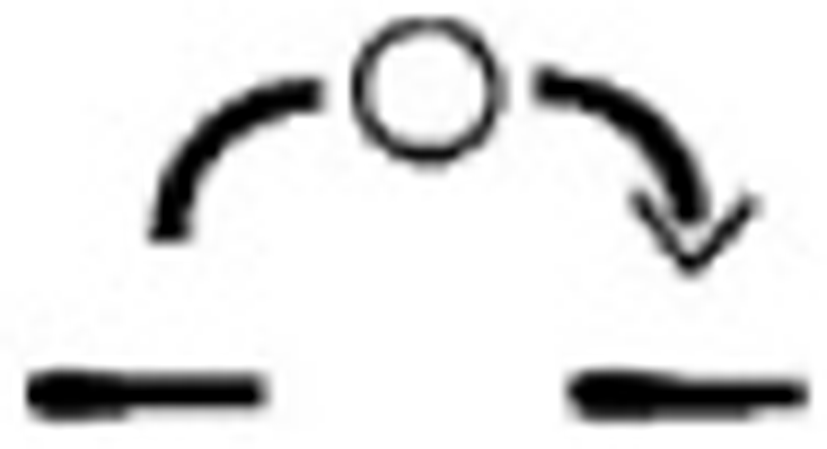 . In this case, this would be a radical that combines ‘change’ with another concept, but you can still pick out the two concepts in it; It is not a totally different character, with nothing in common with
. In this case, this would be a radical that combines ‘change’ with another concept, but you can still pick out the two concepts in it; It is not a totally different character, with nothing in common with 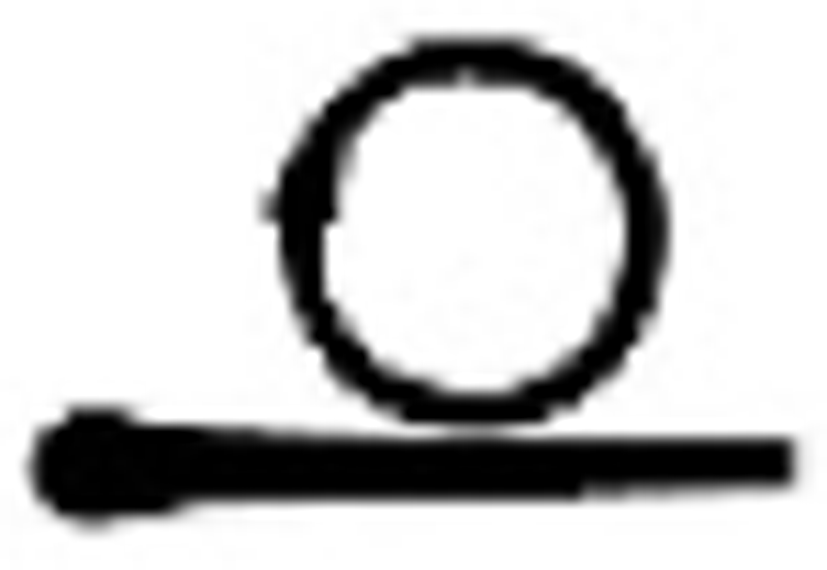 . Hence, I submit that, with
. Hence, I submit that, with 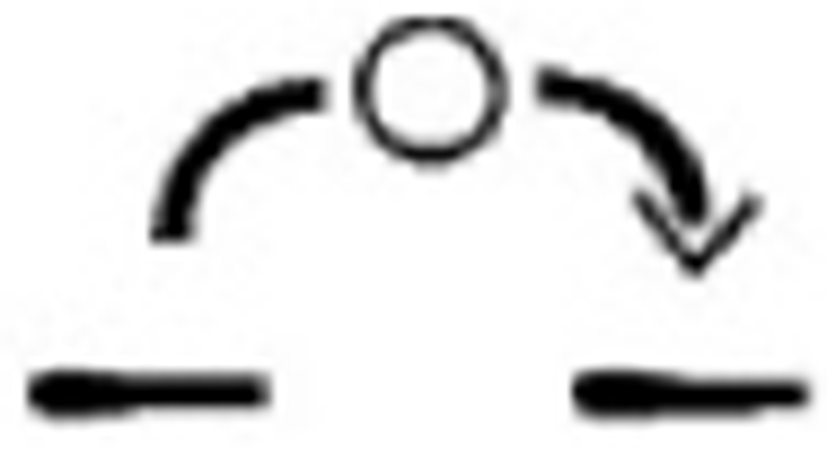 , the user would not be burdened with yet another unique character to have to memorize by rote, and struggle to remember.
, the user would not be burdened with yet another unique character to have to memorize by rote, and struggle to remember.
A second case in which we might consider allowing the change to be part of the radical also involves the single-shafted arrow, representing change or movement, but has to do with reversing the arrow-head, as I discussed in a previous section. To demonstrate, I repeat an example from last section: LoCoS ‘go’ 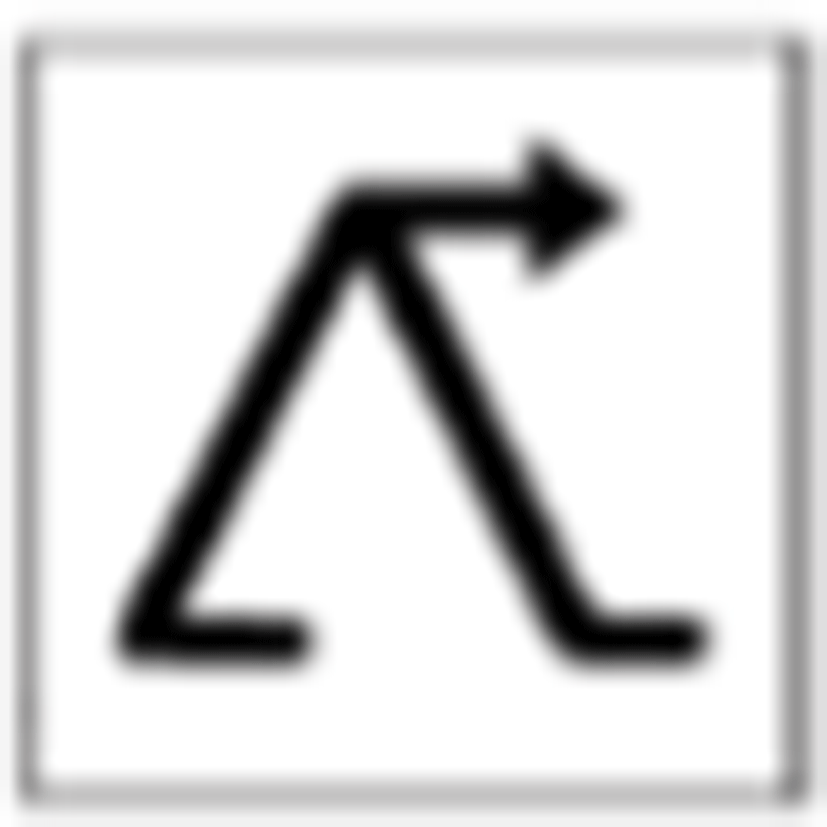 and ‘come’
and ‘come’ 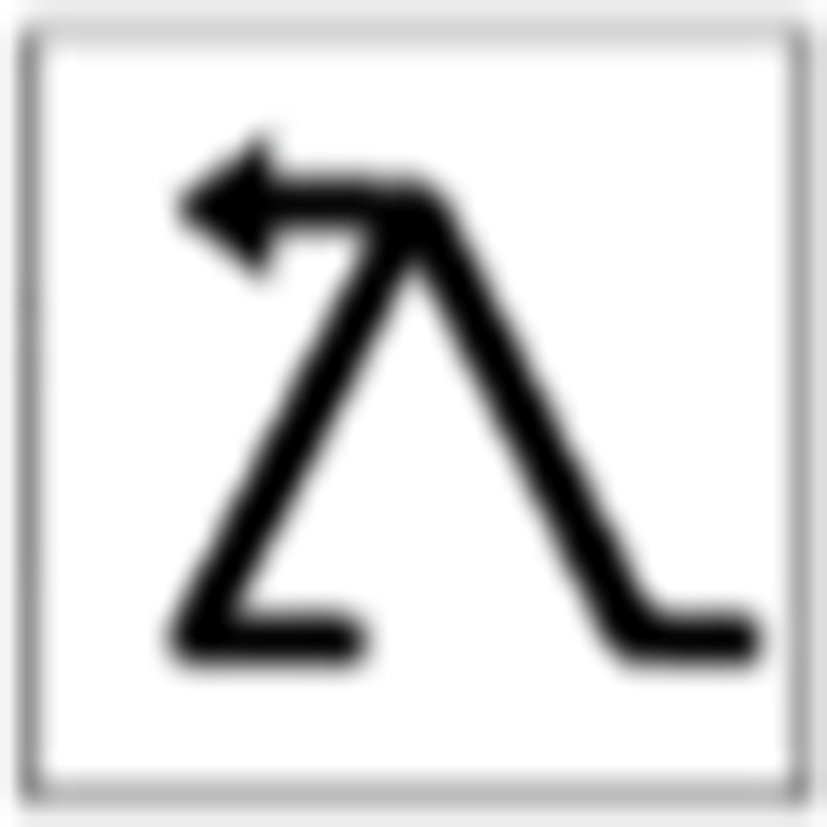 (Aaron Marcus and Associates 2007: 13).
(Aaron Marcus and Associates 2007: 13).
Of course, as I also mentioned in the last section, we could use a gradiential with one of these to yield the opposite, as per ‘come’ via  . An advantage of using the negative mirrored gradiential in cases such as this is that we would have fewer radicals. On the other hand, if we reverse the arrow instead, I do not believe it will increase the memory-burden, because it is the same radical except with the arrow reversed. In addition, I sense reversing the arrow instead of using the negative gradiential could get the point across more directly, i.e., with less mental processing. However, this brings us to another point: In a semantic-writing system, for things we consider unpalatable or embarrassing, such as vomiting, do we want a clear picture? Taking as an example Pictopen ‘eat’
. An advantage of using the negative mirrored gradiential in cases such as this is that we would have fewer radicals. On the other hand, if we reverse the arrow instead, I do not believe it will increase the memory-burden, because it is the same radical except with the arrow reversed. In addition, I sense reversing the arrow instead of using the negative gradiential could get the point across more directly, i.e., with less mental processing. However, this brings us to another point: In a semantic-writing system, for things we consider unpalatable or embarrassing, such as vomiting, do we want a clear picture? Taking as an example Pictopen ‘eat’ 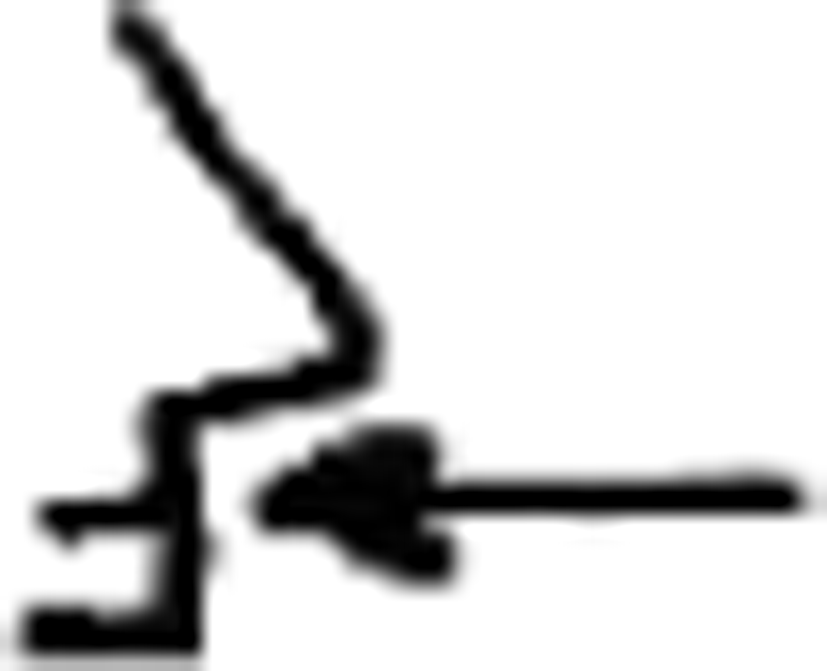 (Garay 2015), might we prefer, at least on some occasions, to express ‘vomiting/being vomited’ as
(Garay 2015), might we prefer, at least on some occasions, to express ‘vomiting/being vomited’ as 
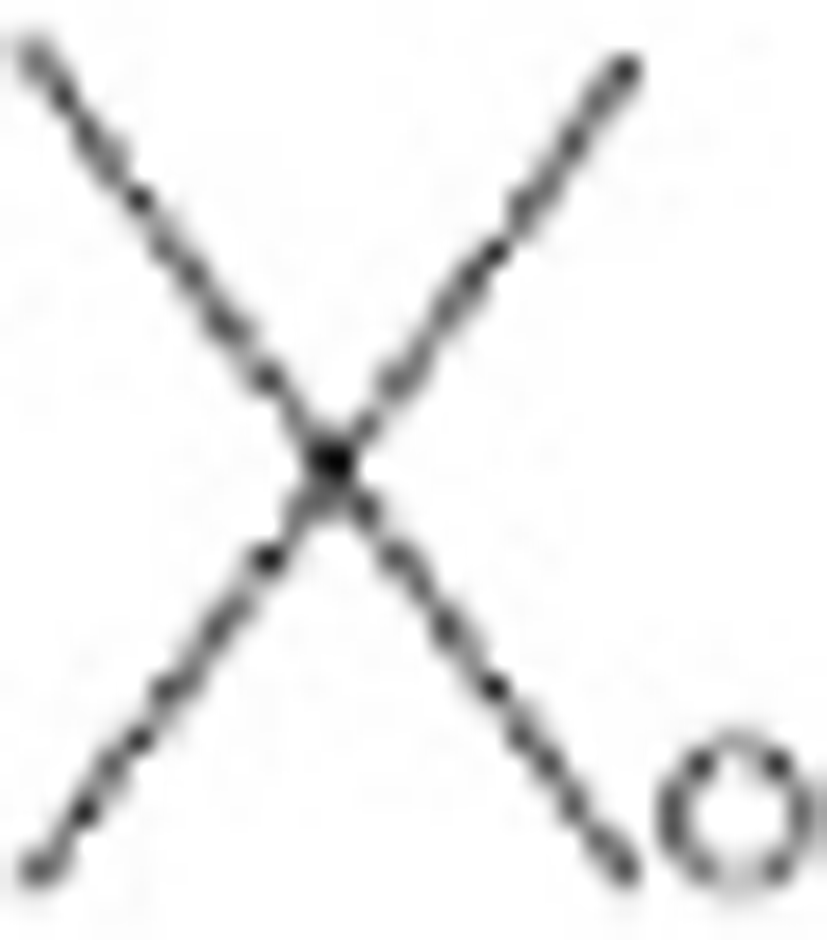 rather than
rather than 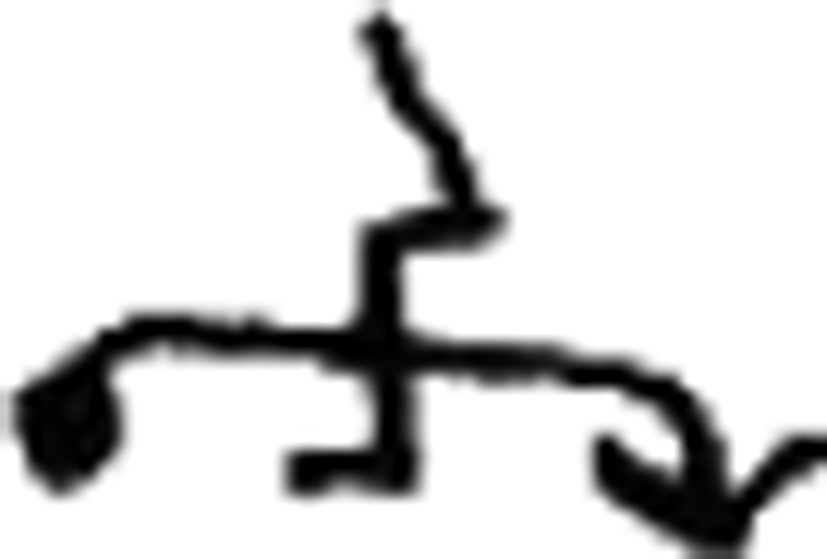 (Garay 2015)? Would this perhaps be preferable as a circumlocution? We could apply the reversed-arrow approach when appropriate, but for very sensitive or squeamish writers or in very delicate situations, circumlocutions such as the one using the negative gradiential would be available as judged suitable by the writer.
(Garay 2015)? Would this perhaps be preferable as a circumlocution? We could apply the reversed-arrow approach when appropriate, but for very sensitive or squeamish writers or in very delicate situations, circumlocutions such as the one using the negative gradiential would be available as judged suitable by the writer.
Returning to the central premise of this disqualifier: By either separating change and the remainder of the semantics into two radicals, or by combining them into one radical but in such a clear and predictable way so as to represent both, and therefore not to increase the memory-burden, we can represent change-related verbs and action-nouns such as “paint” (‘make covered by paint’), “separation”, “give”, “maintenance”24 and thousands more by building on the simpler concepts of ‘change’ + the states, adjectives or other remaining semantic territory, thus sparing the need for thousands of unique radicals to be created and strain users’ memories.
If we wish to limit the number of radicals for both practical and theoretical/philosophical reasons, this disqualifier, which forces adverbs to be represented as prepositional phrases, can be one more tool. Adverbs are equivalent to prepositional phrases; e.g., “drive carefully” could be rephrased as “drive with care” or “drive in a careful manner”. So if we follow this disqualifier, we will not have a radical which means ‘always’; Instead we will use ‘at’ + ‘all’ + ‘times’ or something similar. If all adverbs in spoken languages are represented this way, it will considerably reduce the number of radicals in a semantic-writing system, thus reducing the memory-burden of the user, and presumably painting a more-accurate picture of the world.
Let us consider Bliss ‘easily’ 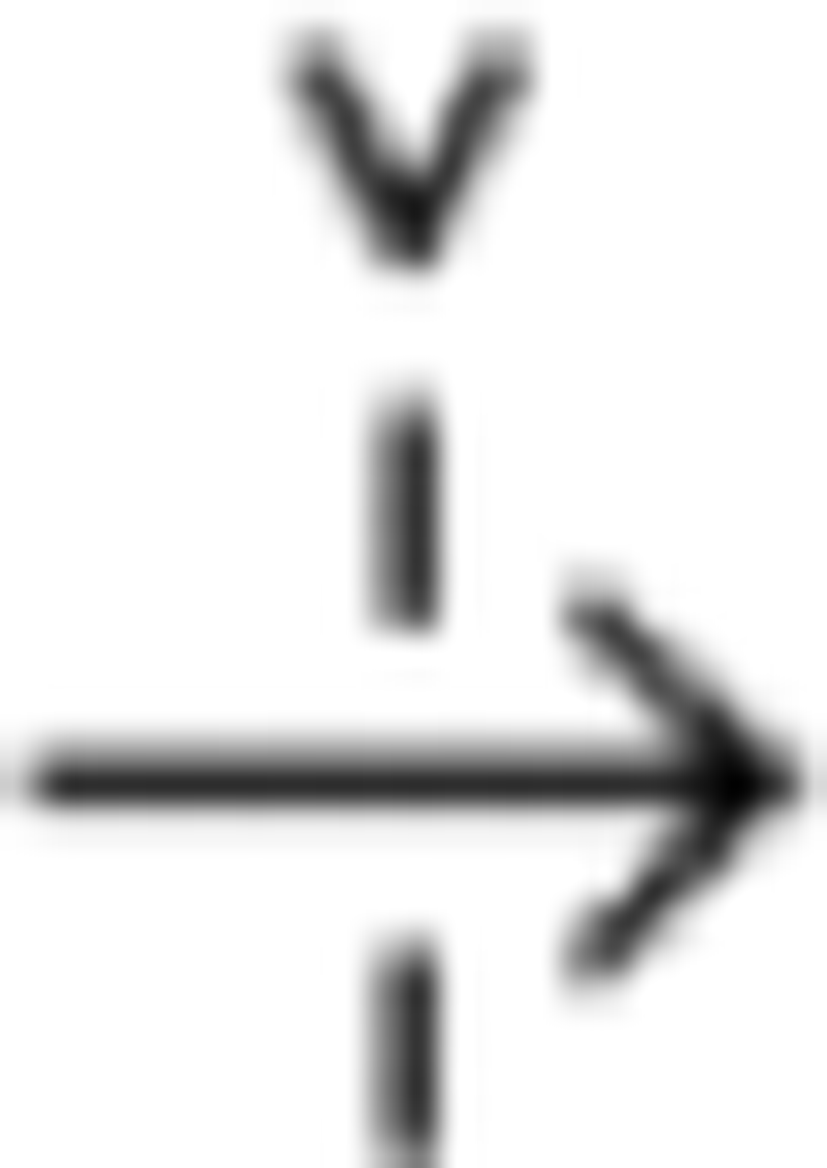 , which is also listed as ‘easy’ (Sutton 2017: 58).25 One can see why the adverb and adjective might have the same form, as they are both modifiers; Nonetheless, their meanings are not precisely the same. In “the ants appear to carry their load easily”, I propose we could replace “easily” with ‘with little effort’ or perhaps ‘by expending little energy’. Compare the adjective in “carrying their load was easy”: Here, I submit that “easy” means something like ‘any action which requires only a little effort’. Hence, the meanings, though closely related, are not exactly the same, which calls for separate expressions for adverbs and adjectives.
, which is also listed as ‘easy’ (Sutton 2017: 58).25 One can see why the adverb and adjective might have the same form, as they are both modifiers; Nonetheless, their meanings are not precisely the same. In “the ants appear to carry their load easily”, I propose we could replace “easily” with ‘with little effort’ or perhaps ‘by expending little energy’. Compare the adjective in “carrying their load was easy”: Here, I submit that “easy” means something like ‘any action which requires only a little effort’. Hence, the meanings, though closely related, are not exactly the same, which calls for separate expressions for adverbs and adjectives.
As a second example, I give ‘where’ as in “Where is my phone-cord?”, in which case ‘at what place’ is the meaning of “where”. LoCoS (Aaron Marcus and Associates 2007: 14) and Bliss (Sutton 2017: 152) have very similar representations for this, respectively  and
and 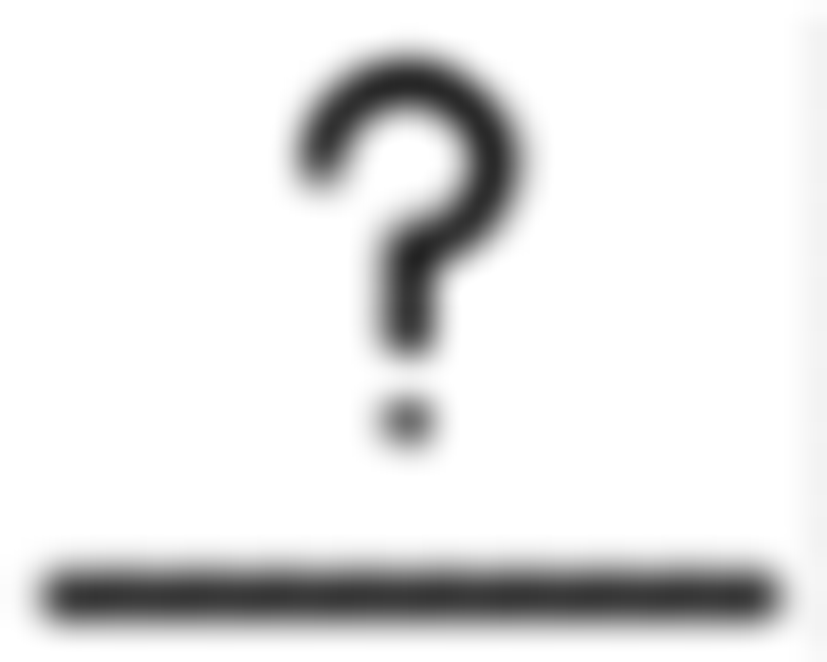 , both of which I would take as ‘at what place?’. If only a preposition such as ‘at’ or ‘associated with’ were placed before them, they would no longer be adverbs, but rather prepositional phrases. Perhaps one may ask what the harm is in having
, both of which I would take as ‘at what place?’. If only a preposition such as ‘at’ or ‘associated with’ were placed before them, they would no longer be adverbs, but rather prepositional phrases. Perhaps one may ask what the harm is in having  and
and  as adverbs. In Section 3.8, when I discuss the conjunction-disqualifier, I will compare ‘where’ as in “I know where your phone-cord is”, and demonstrate how Bliss could avoid that radical if it were to add a preposition to the one above (Table 14).
as adverbs. In Section 3.8, when I discuss the conjunction-disqualifier, I will compare ‘where’ as in “I know where your phone-cord is”, and demonstrate how Bliss could avoid that radical if it were to add a preposition to the one above (Table 14).
| WH-Adverb | Example-Sentence | Meaning |
|---|---|---|
| how | ~ did they get there? | ‘by what means/route’ |
| when | ~ was she born? | ‘on what date’ |
| where | ~ do they live? | ‘at what place’ |
| why | ~ did they move? | ‘for what reason’ |
However, as I just mentioned, WH-words which are conjunctions, e.g., “I don’t know when she was born”, I treat in Section 3.8.
Should we have a radical that means ‘skeleton’, and let ‘bone’ be ‘member of a skeleton’, or should we have a radical that means ‘bone’, and let ‘skeleton’ be ‘system of bones’? Having one radical for ‘bone’ and another for ‘skeleton’ would appear unnecessary and inefficient. And as there are numerous such cases beyond this one example, a principle is called for; It would not be consistent to give a radical to the system/set in some cases but to the member in other cases. If we consider the group to be more complex than the part, then we may wish for a disqualifier against assigning radicals to collections/systems/sets like ‘skeleton’, instead going with the members like ‘bone’. According to this disqualifier, the concept of ‘skeleton’ then has to be represented as ‘system of bones’, and collective nouns like “family”, “gravel”, “luggage”, “fencing”, “furniture”, etc. as ‘group of...’ or ‘set of...’.
Why is consistency important in this case? Having radicals for both ‘bone’ and ‘skeleton’ would increase the number of radicals, possibly requiring more memory on the part of the user. If we have such a disqualifier, then we are guaranteed not to have such needless duplication in a semantic-writing system, and this should be one more way of moving a semantic-writing system into the realm of possibility.
Why disallow the system/set from having its own radical instead of disallowing the member of the system/set? The system/set appears to be more semantically complex, and thus reducible to ‘system/set’ + [other]. However, perhaps toggling the disqualifier the opposite way could work as well.
Alternatively, if the group/set/system were to have a different radical from the member, but predictably and recognizably incorporate the member, then this perhaps would not strain the memories of the users of the system. Both Nobel and Bliss have used this strategy for ‘skeleton’ (Table 15):
| Member | Group/System/Set |
|---|---|
 ‘bone’ (Randić 2009: 20) |
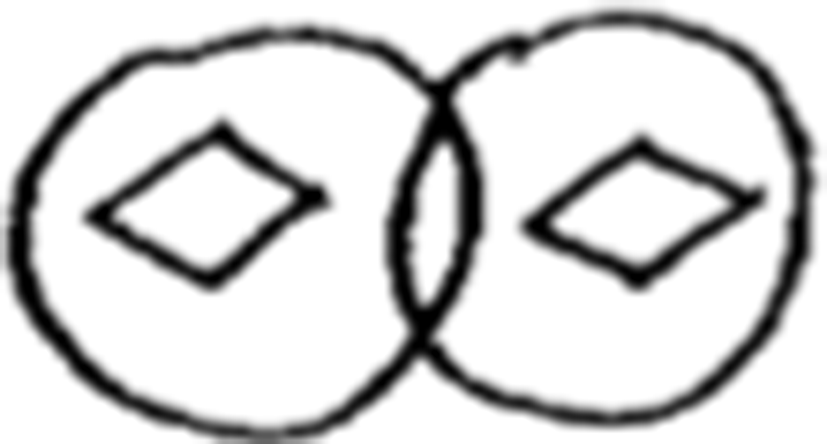 ‘skeleton’; “overlap of bones” (Randić 2009: 32) |
 ‘bone’ (Sutton 2017: 33) |
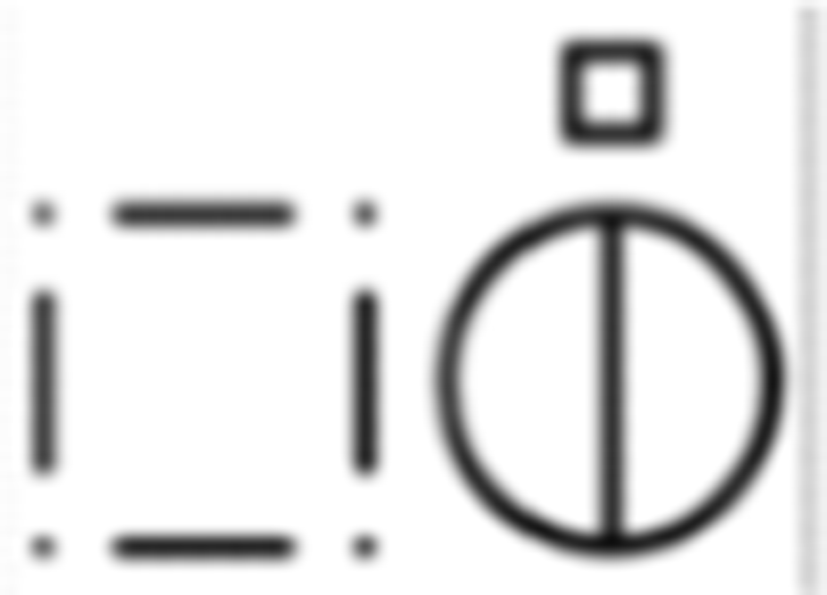 ‘skeleton’ (Sutton 2017: 128) |
What about the intersection of this disqualifier and the action-precedence disqualifier, since a skeleton could perhaps be seen as the means of giving shape to, or supporting, the body? Nevertheless, it is also a set or system: Hence, it is a set or system which is a means of giving shape to the body, and I think should be represented that way.
In some cases, e.g., for ‘hand’, you may have to represent the set of fingers because they are part of the hand. This is a slightly different case because a hand is more than just the fingers; It also includes the palm. So in a case such as ‘hand’ and ‘finger’, I believe this disqualifier is not applicable.
In Sections 2 and 3.2, I showed how arrows applied to action- or state-related radicals can be used to select Θ-roles, for example ‘see-er’ 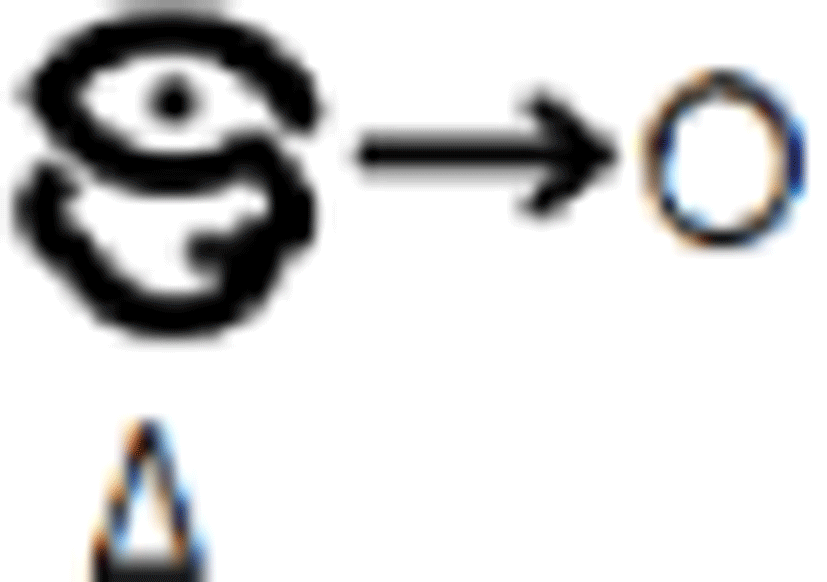 and ‘seen’
and ‘seen’ 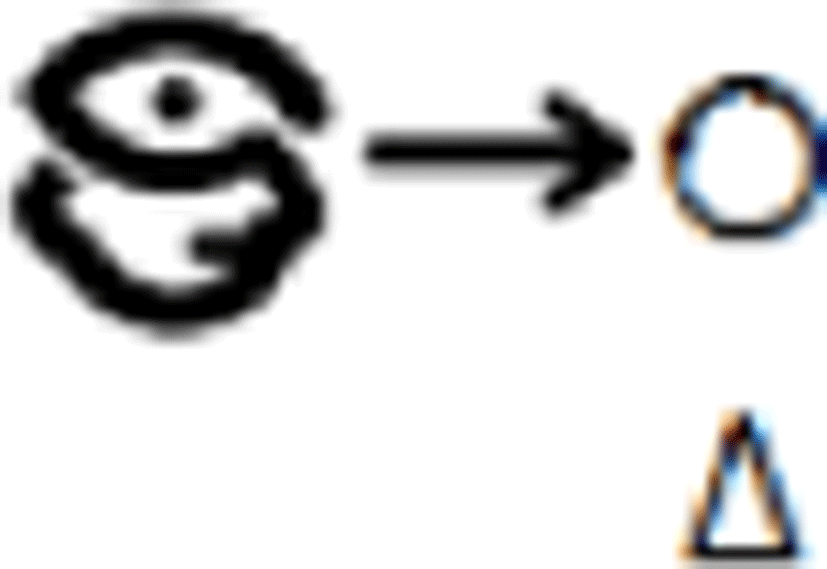 , built on a character from Elephant’s Memory.
, built on a character from Elephant’s Memory.
In Section 3.2, I introduced the action-precedence disqualifier, which states that tools, machines, means, subjects, objects, results, organs of the body with definite purposes, and some job-descriptions should not have their own radicals, but be described by relation to their action.
In both Section 2 and Section 3.2, I said that I would explain how verbs can be constructed from these, and here in Section 3.7 is where I discuss that.
This disqualifier states that semantically, there is really only one finite verb in all languages: Linking-verb “be”, also referred to as the copula, and that all other verbs in all languages can be represented as a combination of the copula plus the thematic role.
Let us now combine ‘see-er’ and ‘seen’ from above with ‘was/were’ from Bliss (Sutton 2017), pronouns from Pictopen (Garay 2015), and ‘of’ of my own creation (Table 16):

|
| ‘I was seen’ |

|
| ‘I was <a> see-er of you’ |
In the first row above, we have glossed an English passive verb, in the second, the active sentence ‘I was a see-er of you’.
But ‘I was a see-er of’ can also be taken to mean ‘I saw’. It has been remarked upon for centuries, for instance in the field of Formal Logic and in the influential French Grammaire générale et raisonnée of 166026 (Arnauld & Lancelot 1975: Chapters XIII, XX, XXII, cited by Cornelius 1965: 123) that all verbs can be reduced to linking ‘be’27 plus thematic roles, such as subject/doer, means, object/done-to, indirect object, result, etc.
How we think of semantic-writing projects is worth some reflection. Bliss alternately refers to itself as “a kind of visual alphabet” (Sutton 2017: 3) and a “language” (Sutton 2017: 9). Elephant’s Memory refers to itself as “a visual language” (Ingen-Housz 1993: 9), LoCoS as “a universal visible language” (Aaron Marcus and Associates 2007: 3), Nobel as a “universal language” (Randić 2009: 1), and Pictopen as a “writing system for international communication based on [pictography]” and a “constructed language” (Garay 2015). I consider my experimental symbol-system and potentially these others to be a way of writing any language via semantic symbols rather than phonological ones. Hence, there are different ways of thinking of semantic writing, perhaps all of them valid.
If we consider a semantic-writing system to be not a language in itself, but a way to write any human language, we may consider glossing all the morphemes such as verb-endings, attempting to place them in the order in which they occur in the language being glossed. This is not necessary for basic communication, but may be useful in second-language study, linguistics, machine translation, or to be sure we have rendered an excellent transcription. Following this line of reasoning, in languages like English, which put at least some endings on verbs, a really accurate transcription for ‘I saw’ would be, using ‘first person’ from Pictopen (Garay 2015); ‘see-er’ from Elephant’s Memory but altered to show theta-role (Ingen-Housz 1993: 19); ‘was/were’ from Bliss (Sutton 2017); NOM28 from present author:
I am claiming, then, that linking “be”, which is to say the copula, would be suffixed to the thematic role if we should attempt to mimic the morphemes. I also am positing that this copula after a thematic is an adequate gloss for DEC, declarative indicative mood, since ‘am/are/is’ is declarative.
Let us look at some additional examples of glossing verbs using semantic characters.
Note that I glossed the person before the copula. That is because in Mvskoke, the other persons are expressed before DEC, which I am hypothesizing can be glossed as the copula when it is declarative and indicative.
The above four examples, from four languages and three continents, illustrate the glossing of verbs contextualized within sentences, in an effort to demonstrate the principle of representing verbs as copula plus theta-role.
Returning to the main point of this section: Why have a disqualifier that states that all verbs except the copula must be represented by the copula plus a thematic role? For one, I, along with the field of Formal Logic and some influential grammarians for the last several centuries, believe that that is truly what a verb is, that the copula plus a thematic role is an accurate representation. Aside from that, remember that we are looking for ways to make a semantic-writing system practical. Representing verbs this way avoids having a huge grammatical category of verbs in the semantic-writing system – with all the complications that that might entail. This disqualifier is indeed a powerful part of our strategy of realizing a fully completed real character.
Conjunctions seem to be definable based on just the conjunctions ‘that’ and ‘than’. Even ‘than’ may be dissolvable (Table 18):
And so forth for any conjunctions not included in the above Table.
As I mentioned in Section 3.5, the adverb “where” in LoCoS (Aaron Marcus and Associates 2007: 14) and Blissymbolics (Sutton 2017: 152) is  and
and 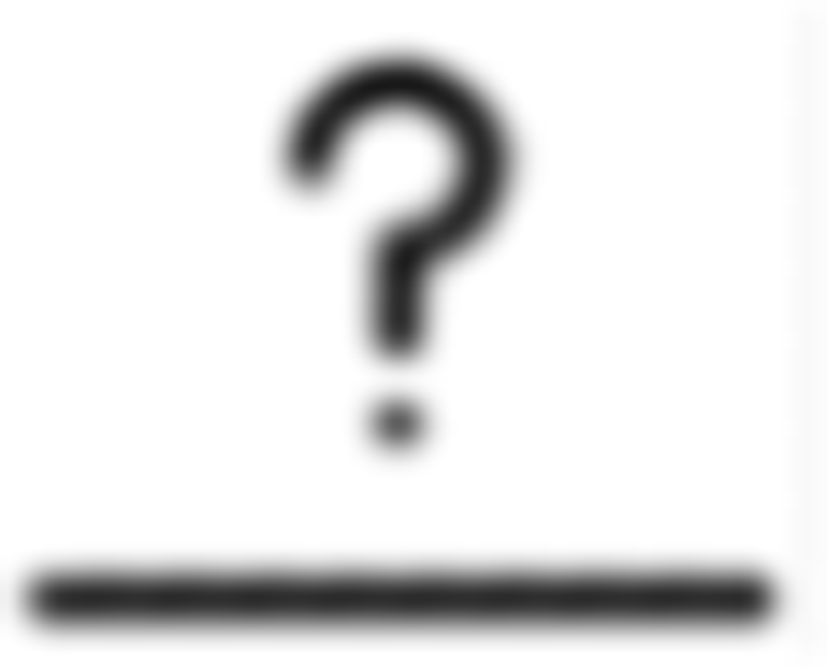 respectively. I propose a preposition be added before it to make the expression a prepositional phrase instead of an adverb. My full proposal, which involves the conjunction and the adverb, is to build the conjunction, the adverb, and the question-word all up from the noun. Using a mix of symbols from LoCoS (‘what’
respectively. I propose a preposition be added before it to make the expression a prepositional phrase instead of an adverb. My full proposal, which involves the conjunction and the adverb, is to build the conjunction, the adverb, and the question-word all up from the noun. Using a mix of symbols from LoCoS (‘what’  (Aaron Marcus and Associates 2007: 13)), Bliss (‘place’
(Aaron Marcus and Associates 2007: 13)), Bliss (‘place’  (Sutton 2017: 109)), and my own devising (‘associated with’
(Sutton 2017: 109)), and my own devising (‘associated with’ 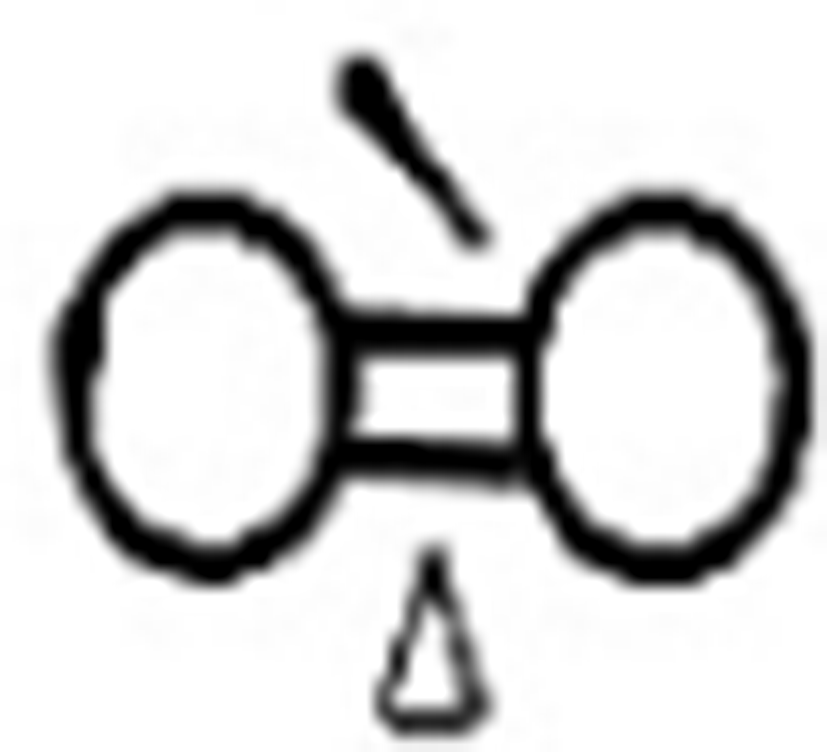 , ‘(the fact) that’
, ‘(the fact) that’ 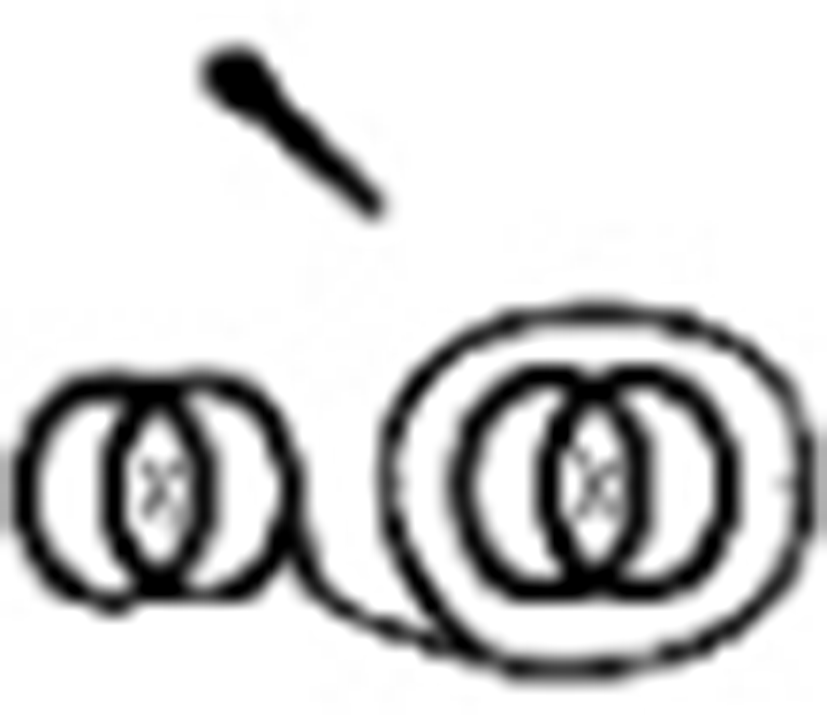 ), here is a demonstration (Table 19):
), here is a demonstration (Table 19):
| Place | What Place | At What Place?; Where? | <The> Place That; Where |
|---|---|---|---|

|

|

|
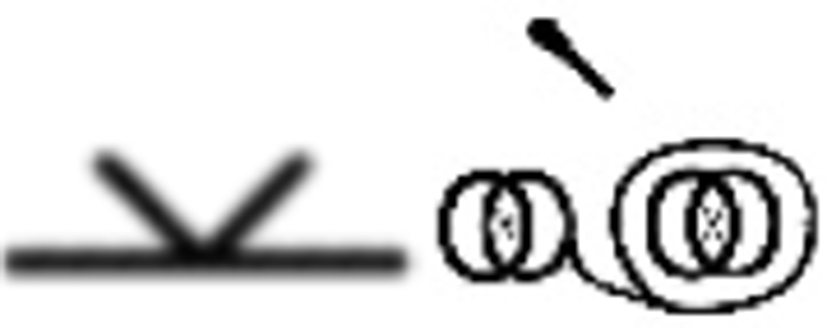
|
Having only one or two conjunctions, and basing all the others on this one or two is a considerable simplification. Every such simplification would appear to increase the feasibility of a semantic-writing system.
4. Sub-Elements
As mentioned in Section 3.1, writers such as Francis Lodowyck and John Wilkins have defined the radical as the basic character, unaltered by marks or other characters, and not derived from other characters. But perhaps even the radical itself could be comprised of sub-elements common to other radicals; This should make the radicals of a semantic-writing system less of a memory-burden, as well as graphically showing similarities among kindred concepts in the radicals, so that radicals of similar meaning would be similar in appearance.
I propose that it would be helpful for creators and revisors of semantic-writing systems to scour their radicals, making a list of sub-elements/devices and their meanings/uses, and then checking for consistency of their employment across all radicals, altering radicals to bring them into conformity if necessary. The user of a semantic-writing system might not have an excellent memory, and taking this step will ease the user’s burden especially if these sub-elements and devices are presented to the user for ease in studying and remembering the radicals. Here are some of the sub-elements and devices I suggest, together with their meanings:
 : While Bliss, LoCos and Pictopen all use the square to mean ‘thing’, (Sutton 2017: 141, Aaron Marcus and Associates 2007, Garay 201529), the circle is quicker and easier for the person writing with a stylus, such as a pen. I would further suggest that the circle mean ‘any person or thing’, applying it thus to any member of the set of this universe.30
: While Bliss, LoCos and Pictopen all use the square to mean ‘thing’, (Sutton 2017: 141, Aaron Marcus and Associates 2007, Garay 201529), the circle is quicker and easier for the person writing with a stylus, such as a pen. I would further suggest that the circle mean ‘any person or thing’, applying it thus to any member of the set of this universe.30
I urge a sub-element representing the mind of a human or nonhuman to be incorporated into radicals dealing with knowing, thinking, believing, feeling and communicating. Thus, over all these classes of radicals, this sub-element would exist consistently, sparing the user’s memory from unnecessary expenditure. Pictopen uses the profile of a human face for ‘tell’ 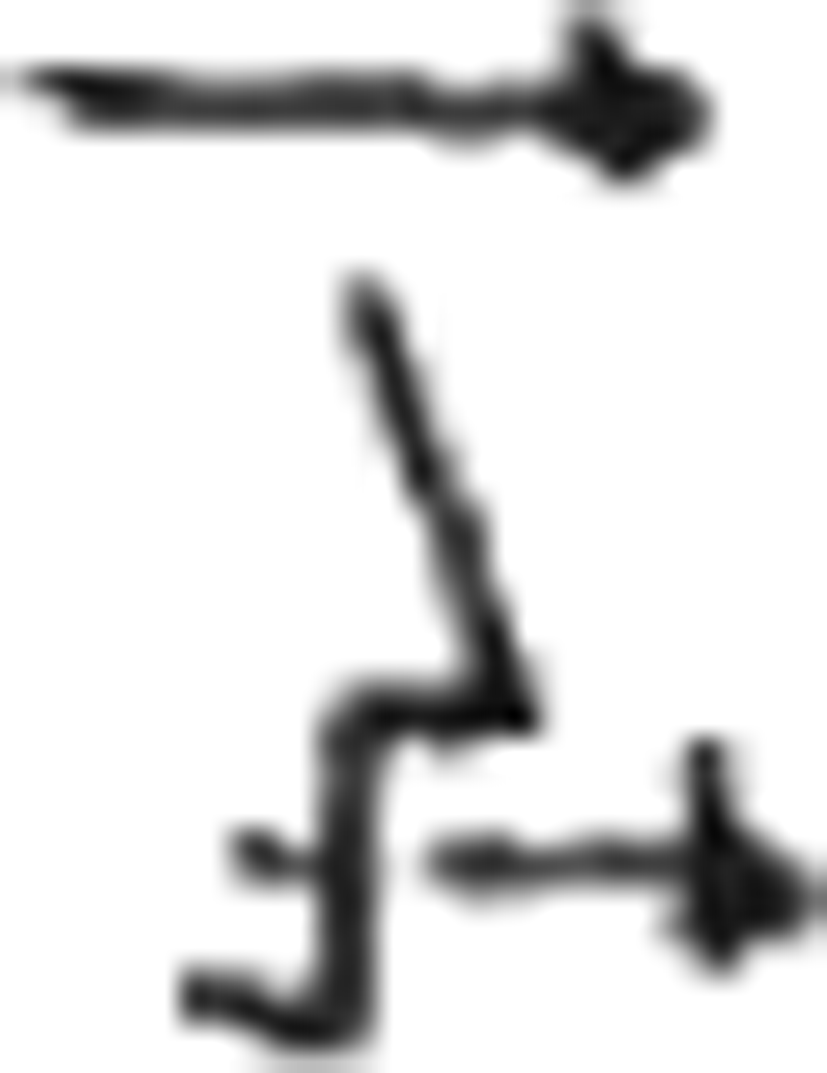 (Garay 2015) and ‘be sad’
(Garay 2015) and ‘be sad’  (Garay 2015); Perhaps this is a suitable candidate, or perhaps something more abstract, and less human-like, since species other than humans have feelings and thoughts, and also communicate.
(Garay 2015); Perhaps this is a suitable candidate, or perhaps something more abstract, and less human-like, since species other than humans have feelings and thoughts, and also communicate.
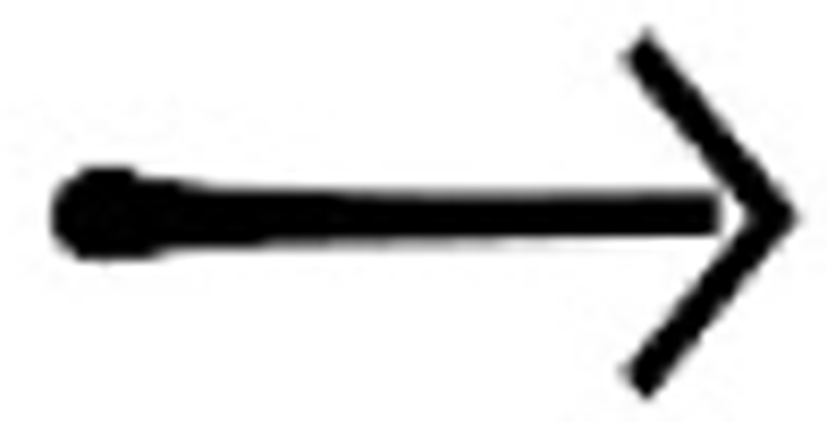 : I suggest that the single-shafted arrow, as opposed to the shaftless arrow-head or the double-shafted arrow, is suitable to indicate movement or other change.31
: I suggest that the single-shafted arrow, as opposed to the shaftless arrow-head or the double-shafted arrow, is suitable to indicate movement or other change.31
I suggest arcs are highly intuitive for grammatical person, per: 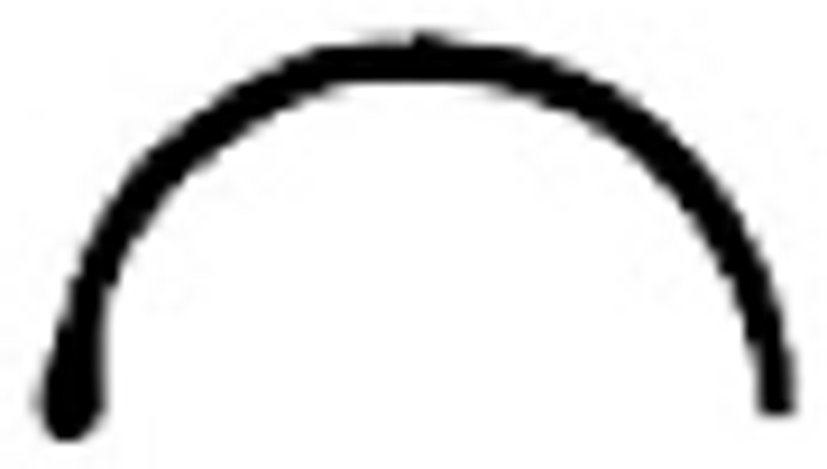 for first person,
for first person,  for second person, and
for second person, and 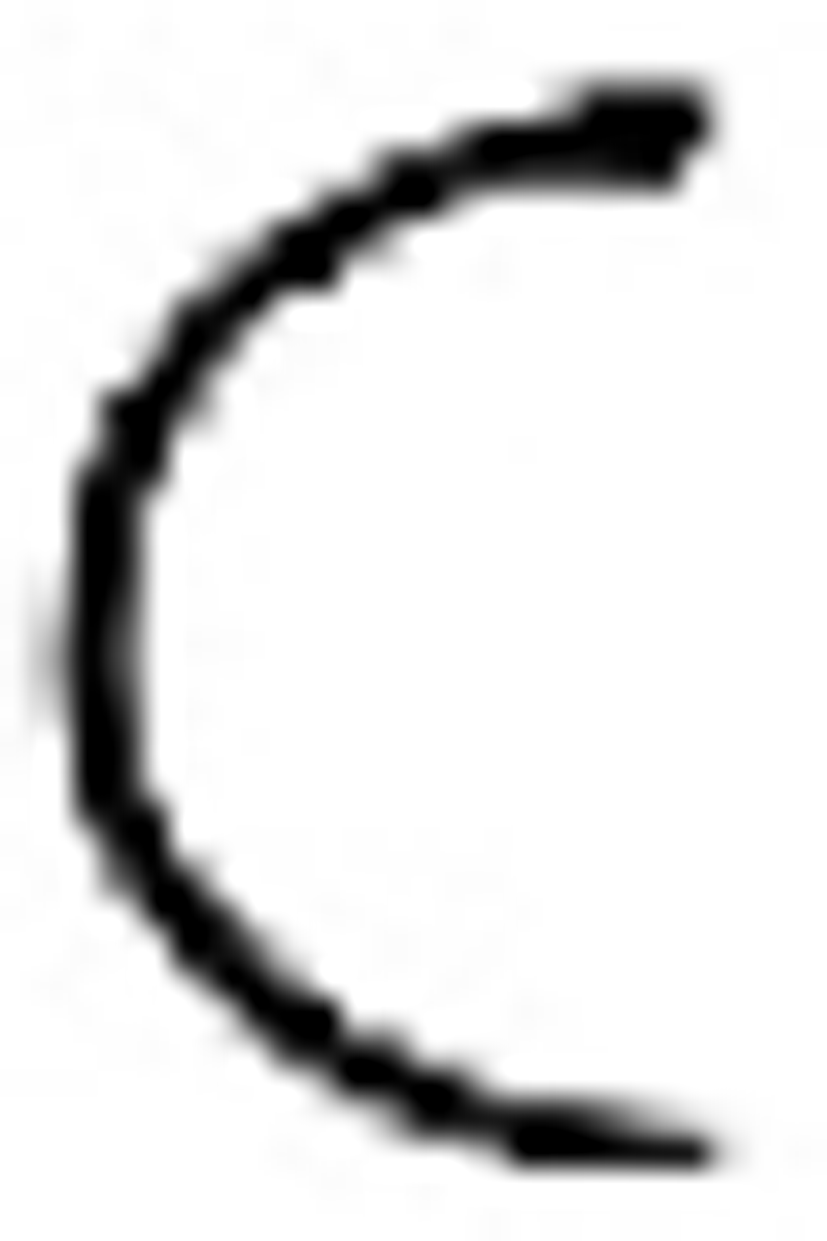 for third person. Imagine you are kneeling or squatting on a sandy surface, facing another person. If each of you should draw a semi-circle in front of you, you would have demarcated first and second person. Third person can be conceived as another person or thing or other people or things off to one side.
for third person. Imagine you are kneeling or squatting on a sandy surface, facing another person. If each of you should draw a semi-circle in front of you, you would have demarcated first and second person. Third person can be conceived as another person or thing or other people or things off to one side.
 : I nominate the asterisk to represent energy, the potential to do work. Perhaps it could also be involved in representations of ‘life’ and living things.
: I nominate the asterisk to represent energy, the potential to do work. Perhaps it could also be involved in representations of ‘life’ and living things.
 : I suggest the device of “dashèdness” or dashing be used to indicate where something will, would, should, can, could, may, or might be. We have all seen this used on line-charts for projections past the present time; It’s so common that popular graph-making software-programs have the option of dashing segments of the lines. Figure 1 is a demonstration created for this purpose by the author.
: I suggest the device of “dashèdness” or dashing be used to indicate where something will, would, should, can, could, may, or might be. We have all seen this used on line-charts for projections past the present time; It’s so common that popular graph-making software-programs have the option of dashing segments of the lines. Figure 1 is a demonstration created for this purpose by the author.
Many of us have likely also seen it on maps, blueprints, architectural drawings, and diagrams showing where a new thing might, or will, be constructed; Hence, this device is already familiar to us.
 : I suggest double solid lines, whether straight or curved, can be used to show blocking, separation, or strengthening of a barrier, that adding a second line reinforces the first, making for a stronger and surer separator.
: I suggest double solid lines, whether straight or curved, can be used to show blocking, separation, or strengthening of a barrier, that adding a second line reinforces the first, making for a stronger and surer separator.
In (13) above, I suggested assigning the circle the meaning ‘any person or thing’ among the more-ideographic characters. But in the more-pictographic characters, the circle will be needed to represent a round or spheroid object. I believe that in many cases, it will be obvious whether a character is ideographic or pictographic, leading to no confusion. However, suppose there is a chance of misunderstanding: In such a case, I propose that shading be used in more-pictographic characters to confirm that a circle, or other shape we may have assigned a meaning among the more-abstract characters, actually does represent a two- or three-dimensional object. By way of example, suppose we wanted to represent ‘gravity’ with a character such as 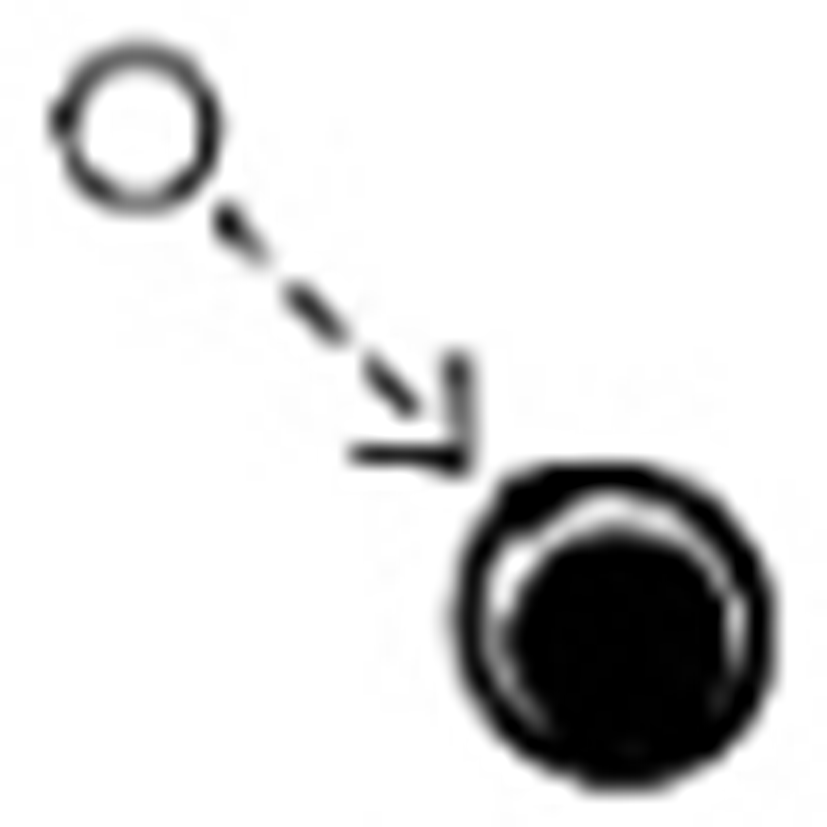 , in which the smaller circle would mean ‘any person or thing’, while the larger circle would represent an actual spheroid object, a planet. Because items of all shapes are subject to gravity, the smaller circle is unshaded, carrying its abstract meaning of ‘any person or thing’, but because large heavenly bodies are spheroid due to their great gravity (Gregersen 2016), the larger circle, representing a planet, is shaded. I do not suggest we apply shading to every two- or three-dimensional object, which I would view as needlessly complex, and also very counterintuitive in some cases, such as for ‘star’ and ‘sun’, given that a star is such a tremendously bright object, yet shading would render it black! Rather, I propose the use of shading when truly necessary, as in ‘gravity’ above.
, in which the smaller circle would mean ‘any person or thing’, while the larger circle would represent an actual spheroid object, a planet. Because items of all shapes are subject to gravity, the smaller circle is unshaded, carrying its abstract meaning of ‘any person or thing’, but because large heavenly bodies are spheroid due to their great gravity (Gregersen 2016), the larger circle, representing a planet, is shaded. I do not suggest we apply shading to every two- or three-dimensional object, which I would view as needlessly complex, and also very counterintuitive in some cases, such as for ‘star’ and ‘sun’, given that a star is such a tremendously bright object, yet shading would render it black! Rather, I propose the use of shading when truly necessary, as in ‘gravity’ above.
I propose the sub-element of the link/bridge to show ‘association’, ‘associated with’, ‘having to do with’, ‘having in common’. Combining this with the circle and person-arcs from above, an example of a resultant character might be 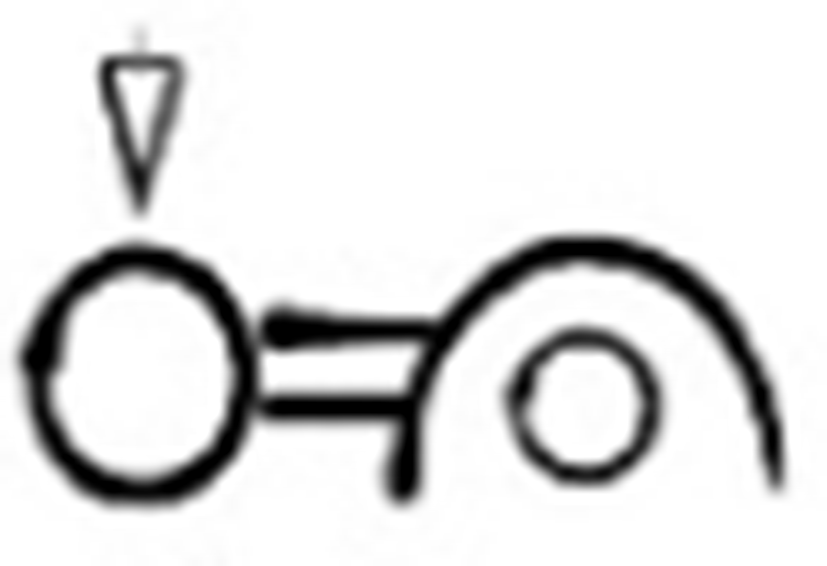 for ‘my/mine’, literally ‘any person or thing which is associated with me’.
for ‘my/mine’, literally ‘any person or thing which is associated with me’.
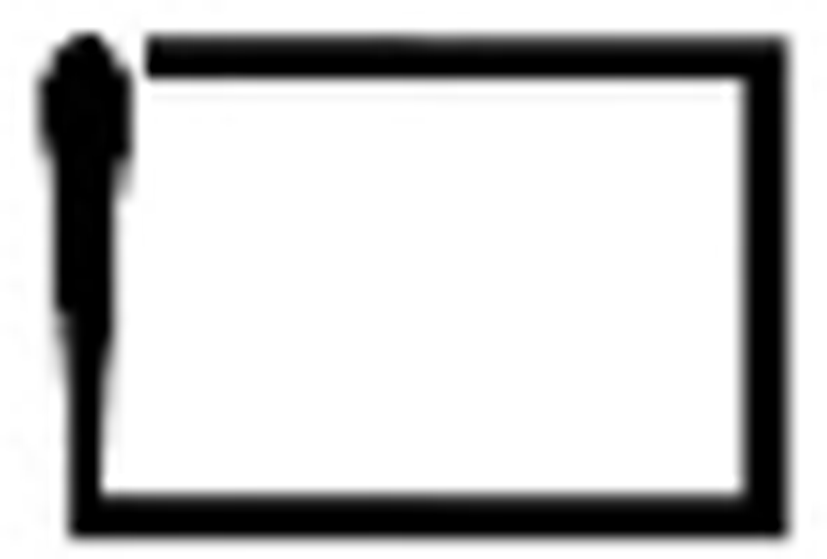 : While Bliss, LoCoS, Nobel and Pictopen use the square to mean ‘thing’ as noted above, I suggest the assignment of the square or rectangle be modified to ‘human-made thing’, as my observation is that most squares and other rectangles are produced by humans rather than by nature. If we wanted to define “machine” as ‘any human-made thing with multiple parts through which energy passes’, combined with the arrow, the circle, and the asterisk for energy, we might consider
: While Bliss, LoCoS, Nobel and Pictopen use the square to mean ‘thing’ as noted above, I suggest the assignment of the square or rectangle be modified to ‘human-made thing’, as my observation is that most squares and other rectangles are produced by humans rather than by nature. If we wanted to define “machine” as ‘any human-made thing with multiple parts through which energy passes’, combined with the arrow, the circle, and the asterisk for energy, we might consider 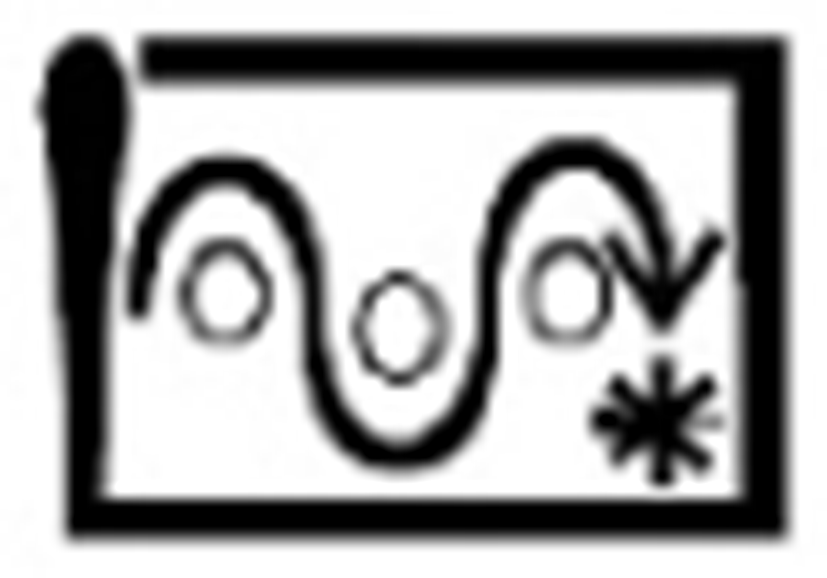 for ‘machine’. This sub-element would be ideographic in the sense that not everything humans produce is rectangular, I realize. In a pictographic character showing a human-made thing that was not rectangular, I would suggest a different shape which would more closely approximate the item being glossed.
for ‘machine’. This sub-element would be ideographic in the sense that not everything humans produce is rectangular, I realize. In a pictographic character showing a human-made thing that was not rectangular, I would suggest a different shape which would more closely approximate the item being glossed.
A semantic-writing system may contain hundreds of, or more likely a few thousand, radicals. We would be wise to consider ways of reducing the memory-burden for the user. Reusing sub-elements among radicals is one possible strategy toward accomplishing this. Not only would the memory-burden be reduced, but the Alphabet of Human Thought would be more accurately expressed, as the radicals would be composed to a greater extent of a smaller number of simpler pieces of meaning. This would have pleased Leibniz and Descartes, as they proposed an innate benefit in this inasmuch as radicals would be mini-definitions of the things they signified, resulting in a system which would more purely correlate form to meaning.
5. Conclusion
In this paper, proposals are made for reducing the number of radicals in a semantic-writing system, and even for building radicals out of still smaller pieces of meaning. Having as few characters as possible is a powerful tool toward reducing the user’s burden, as is building the characters out of smaller pieces of meaning, as I discussed in Section 4.2. Beginning with rigidly formulaic definitions which are primary, and then using the characters and sub-elements to encode them will provide a rationale to the user, further reducing his or her burden. Assuming we create an entire and complete system by utilizing these strategies, I believe the student with even moderately serious intent will prevail.
Aside from the number of basic symbols to be learned, an additional conceivable difficulty might be raised regarding universality of symbols, as users from various cultural and linguistic backgrounds might erroneously associate them with meanings other than those intended by their creators. Research and discussion along the lines of the meanings of symbols in different cultures should be considered; nonetheless, in the end, a student will have to learn some new things, as always happens when embarking upon some new pursuit; I myself have associated unintended meanings with some of the symbols of some of the other systems, at least upon first making their acquaintance, an example from Bliss being  for ‘language’ (Sutton 2017: 88). Yet, I have found that if the rationale of the characters, i.e., the correlation between meaning and form, is made known to me, then I can thereafter easily remember these characters. In this case, once I learned that this character for ‘language’ consists of two sub-elements: The circle meaning ‘mouth’, and the other ‘ear’, I have never forgotten the meaning of the symbol for ‘language’ or for ‘mouth’ or ‘ear’. It is not a question of “universality” as much as acquiring a new system, and using its internal logic to aid in that process. I have, however, had difficulty remembering characters which were neither pictographic nor had apparent rationale, such as
for ‘language’ (Sutton 2017: 88). Yet, I have found that if the rationale of the characters, i.e., the correlation between meaning and form, is made known to me, then I can thereafter easily remember these characters. In this case, once I learned that this character for ‘language’ consists of two sub-elements: The circle meaning ‘mouth’, and the other ‘ear’, I have never forgotten the meaning of the symbol for ‘language’ or for ‘mouth’ or ‘ear’. It is not a question of “universality” as much as acquiring a new system, and using its internal logic to aid in that process. I have, however, had difficulty remembering characters which were neither pictographic nor had apparent rationale, such as  for ‘a/an’ (Sutton 2017: 20) and
for ‘a/an’ (Sutton 2017: 20) and  for ‘the’ (Sutton 2017: 140). Most languages of the world do not contain articles, and speakers of these languages have consistent difficulty learning to use them when studying second languages which do have them (Park & Tak 2017). Therefore, it seems quite urgent that some explanation be given to learners of Bliss for these two characters, or that they be changed to characters which somehow attempt to represent the meanings, such as my own experimental character’
for ‘the’ (Sutton 2017: 140). Most languages of the world do not contain articles, and speakers of these languages have consistent difficulty learning to use them when studying second languages which do have them (Park & Tak 2017). Therefore, it seems quite urgent that some explanation be given to learners of Bliss for these two characters, or that they be changed to characters which somehow attempt to represent the meanings, such as my own experimental character’  ‘a/an; one of a group’ and
‘a/an; one of a group’ and  ‘the (singular); sole member of a set’.
‘the (singular); sole member of a set’.
But can we create such a system? A complete ideographic writing-system may seem almost impossible if one envisions a unique radical for each thought or idea or word imaginable. Yet if one instead considers the strategies below, the prospect becomes more promising:
-
The selector to derive multiple meanings from one character,
-
Disqualifiers to promote the principled use of combinations of characters to represent most things in the universe, as I have enumerated above, and
-
Comprising radicals of sub-elements which maintain their meanings or uses among multiple radicals.
With these advantages, the possibility of a complete semantic-writing system begins to seem much more realistic. Not only that, but by using these strategies, I believe that the vision of the 1600s writers such as Descartes and Leibniz may be more closely approached, as these defining-rules force closely-related concepts to have closely-related representations. What would the value be in that? The hope has been that it would increase the speed and amount of learning which an individual would achieve, thus better preparing him or her for important work in fields such as medicine, technology, law, science, philosophy, etc., and simply resulting in its users’ having a deeper and clearer understanding of the universe.

 for ‘skiing’ represent meaning rather than sound. For centuries, great minds such as Descartes, Leibniz, Francis Lodowyck, and Rev. John Wilkins have called for the creation of a writing-system comprised completely of semantic characters. Such a writing-system must possess enough characters to represent the universe; But too many characters will pose a challenge for users to learn and remember. This article argues for principles limiting the number of basic, non-derived characters (“radicals”) while maximizing the expressive power coaxed from them. I advance three primary strategies here: First, use of the arrow or other selector to derive related meanings from one radical (e.g.,
for ‘skiing’ represent meaning rather than sound. For centuries, great minds such as Descartes, Leibniz, Francis Lodowyck, and Rev. John Wilkins have called for the creation of a writing-system comprised completely of semantic characters. Such a writing-system must possess enough characters to represent the universe; But too many characters will pose a challenge for users to learn and remember. This article argues for principles limiting the number of basic, non-derived characters (“radicals”) while maximizing the expressive power coaxed from them. I advance three primary strategies here: First, use of the arrow or other selector to derive related meanings from one radical (e.g., 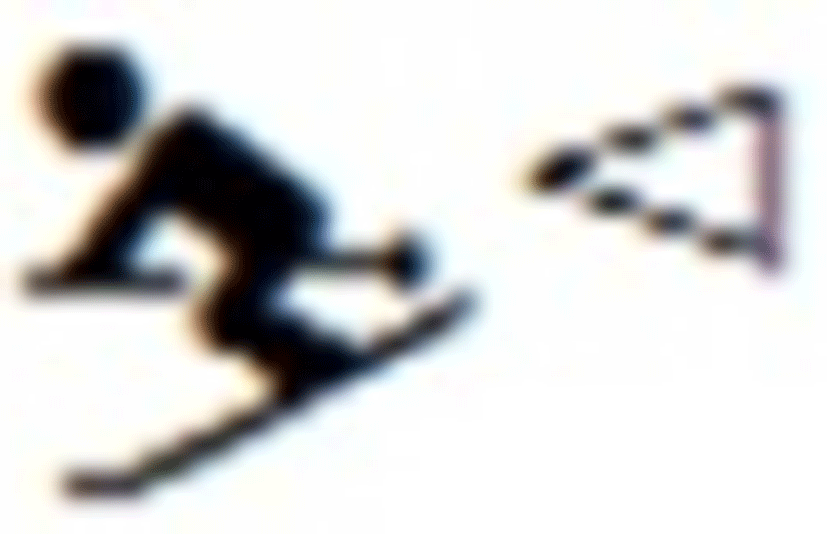 for ‘skier’ as opposed to
for ‘skier’ as opposed to 